Real Thai Cooking : Recipes and Stories from a Thai Food Expert Chawadee Nualkhair
Visit to download the full and correct content document: https://ebookmass.com/product/real-thai-cooking-recipes-and-stories-from-a-thai-food -expert-chawadee-nualkhair/
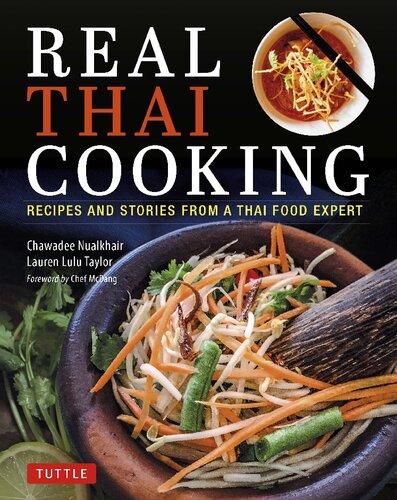
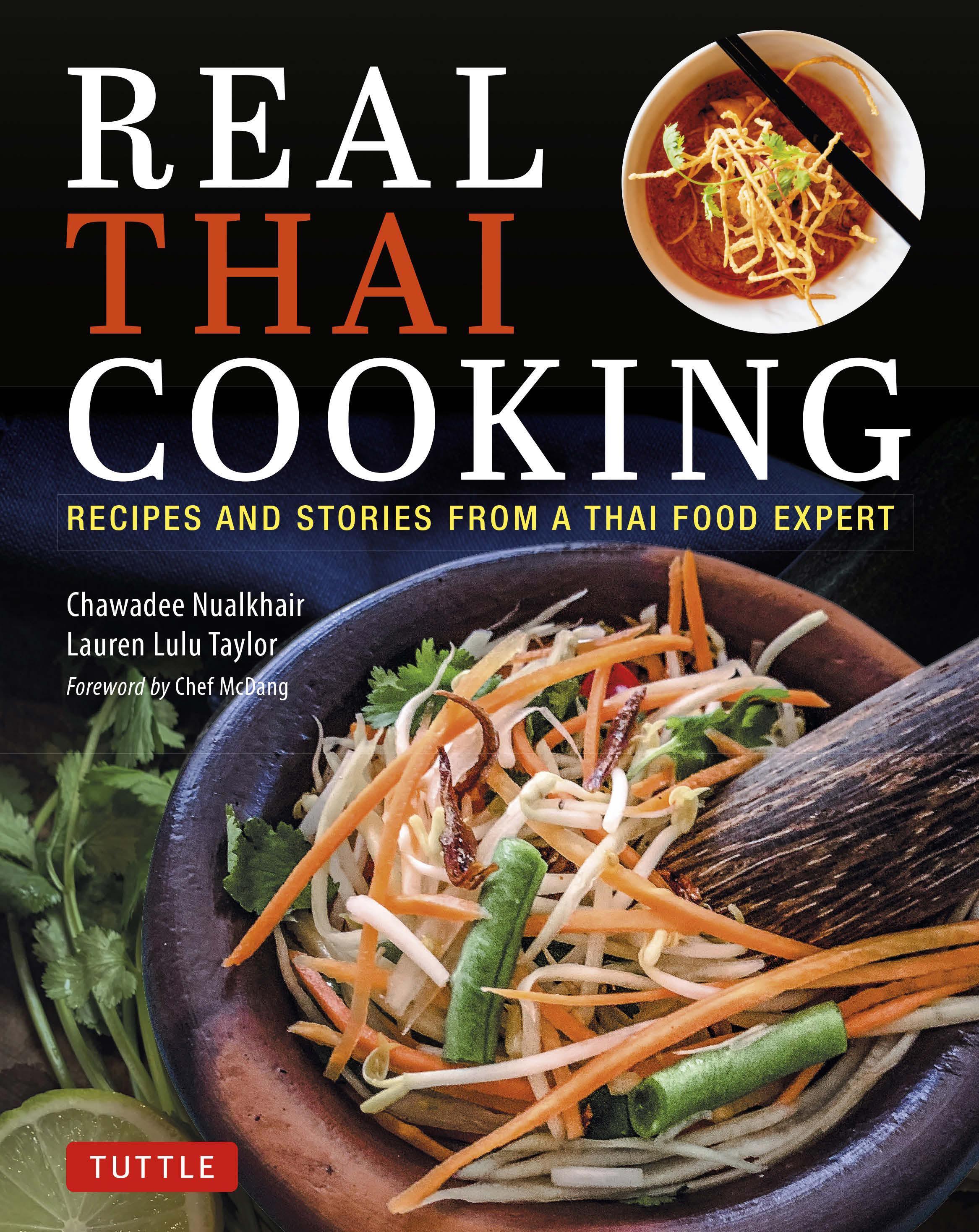
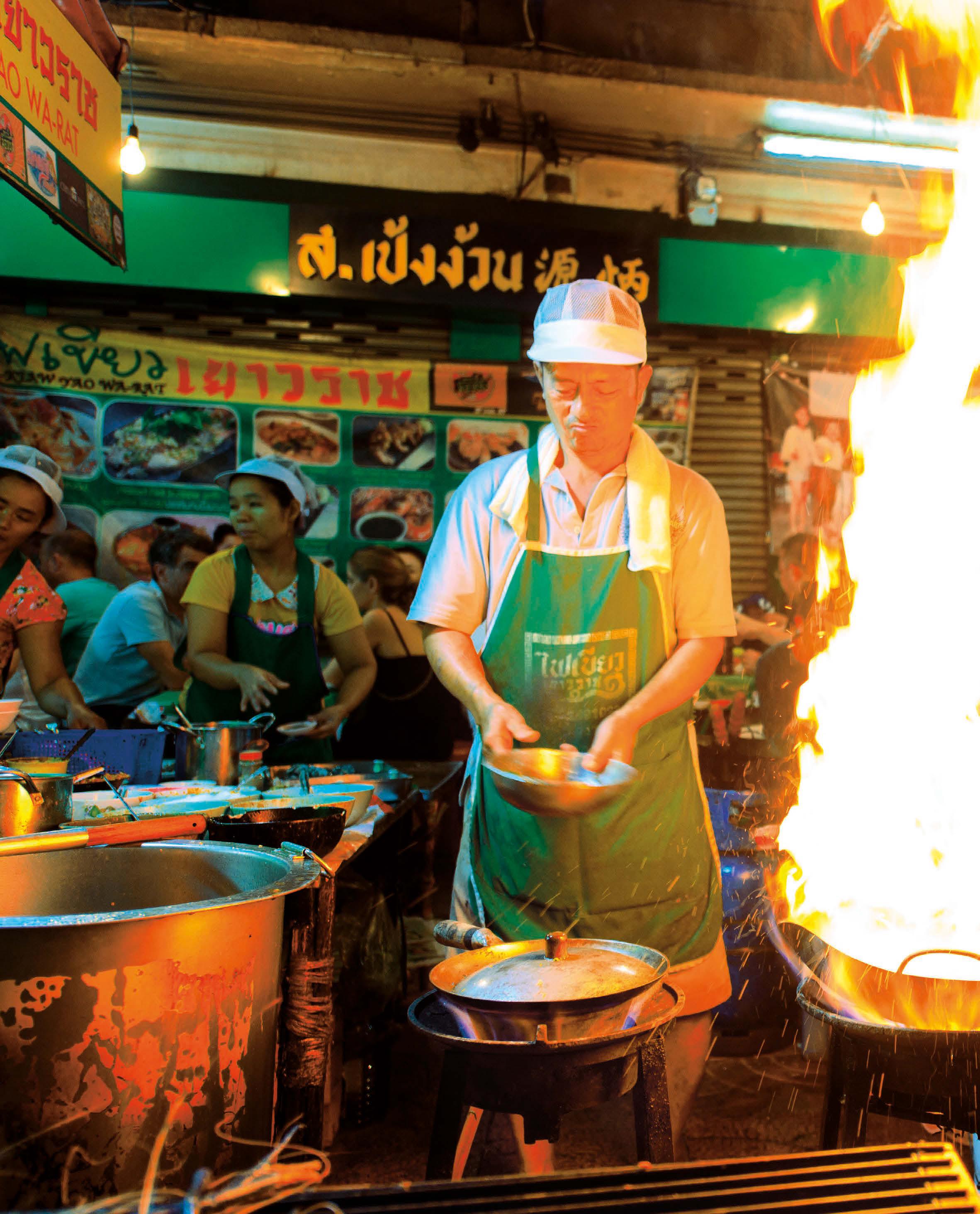
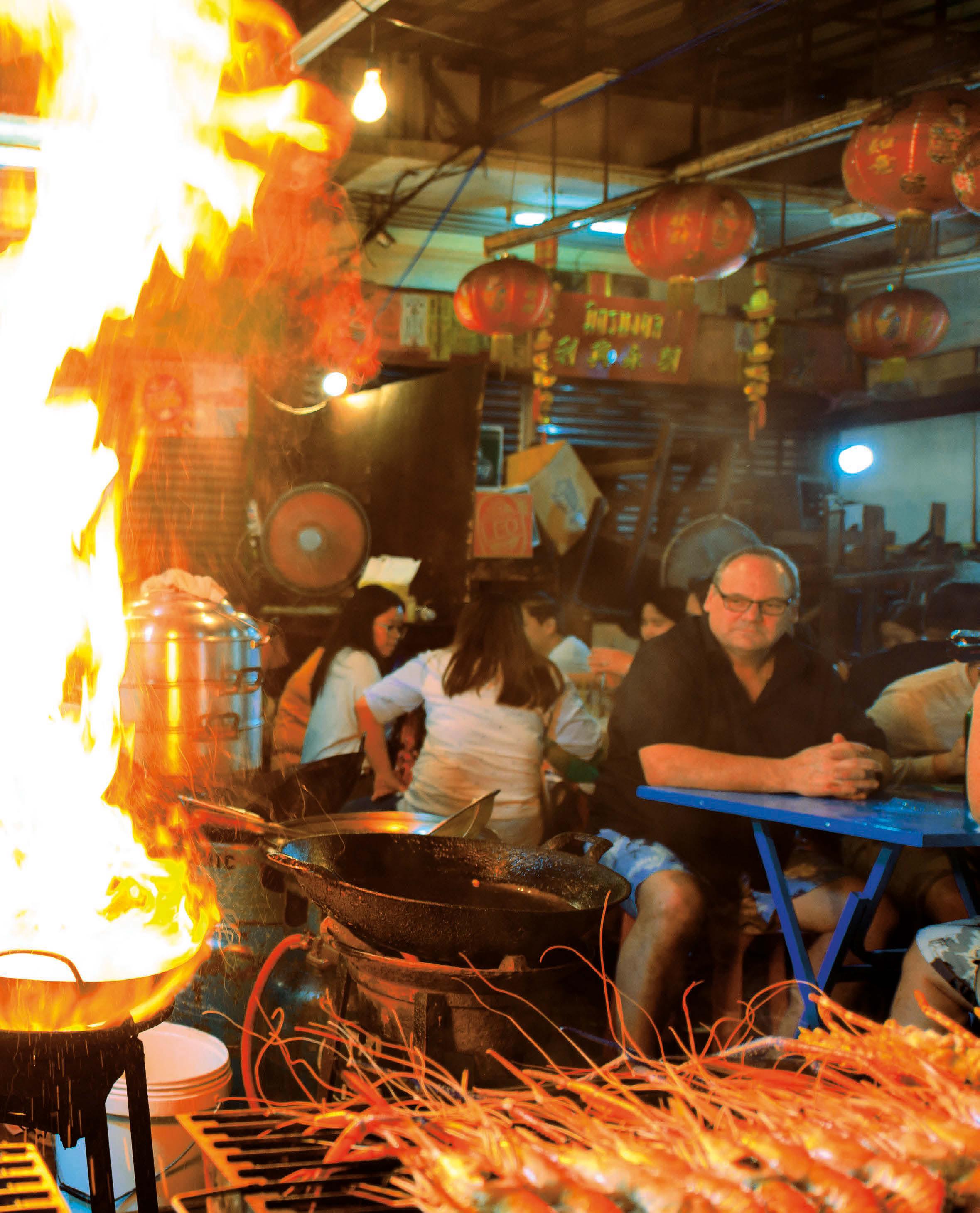

“I felt like the luckiest person on earth when I not only met Chawadee, but had her as my personal food navigator through Bangkok. We walked, boated, and ate our way through some of the best food I’ve ever had, all thanks to Chawadee, her warmth and expertise. And now you get to have the next best thing: her fantastic book. Enjoy every delicious bite.”—Phil Rosenthal (“Somebody Feed Phil”)
“After traveling to Thailand for many years to eat, I found Chawadee’s Bangkok’s Fifty Best Food Stalls book online and had the temerity to contact her, hoping for suggestions. Next thing I knew I made a friend for life. But more importantly, I had the best guide to eating in Thailand a Thai food fanatic could ask for. Her palate should be declared a National Treasure.—Robert Mark Kamen, screenwriter and creator of The Karate Kid,Fifth Element, The Transporter and Taken


“Real Thai Cooking covers many of the popular dishes that people in Thailand eat on a day to day basis, dissected into recipes, with stories and detailed explanations to help them make sense. From ingredients, to meal plans, recipes, and valuable Thai cultural context, Real Thai Cooking is a fantastic overview into the world of Thai food, and how you can make it at home.”—Mark Wiens, migrationology.com
“The variety of Thai street food is so wide that this cookbook will be your best friend to help explore safely the secret flavours of Thai cuisine and not to miss any.”—Stephane Junca, director of Secret Retreats (secret-retreats.com)
“This book made me want to jump on a plane and eat my way round Thailand again—and this time, I would finally come to understand the secrets of Thai food customs. . . Real Thai Cooking is a musthave for any serious Thai food lover!”—Anne Faber, presenter of “Anne’s Kitchen” and author of My Luxembourg: Home Sweet Home



“Real Thai Cooking is a fitting name for this well crafted, accurately detailed, regional, cultural and sometimes historical account of the food I love. Chow’s knowledge and passion for Thai cuisine flows from these pages with insights and reflections that offer a nuanced understanding of the many aspects of the Thai culinary landscape.”—Dylan Jones, chef and co-owner of Err and The Food Trust
“What an easy book to like. And what a wonderful book to read and learn to love Thai food. I’m seduced ... ”—David Thompson, chef and author of Thai Food
“Chawadee’s new book Real Thai Cooking brings back childhood memories of fabulous foods that are classic and authentic. She has traipsed each region of Thailand and taken their culinary highlights and different cooking styles from family to street, from homegrown to hybrid. It’s filled with interesting anecdotes on ingredients, history, recipes and, not to mention, mouth-watering photos of colourful and flavourful food.”—Thomas Vitayakul, academic and owner of Ruen Urai



REAL THAI COOKING
RECIPES AND STORIES FROM A THAI FOOD EXPERT
Chawadee Nualkhair
Lauren Lulu Taylor
Foreword by Chef McDang








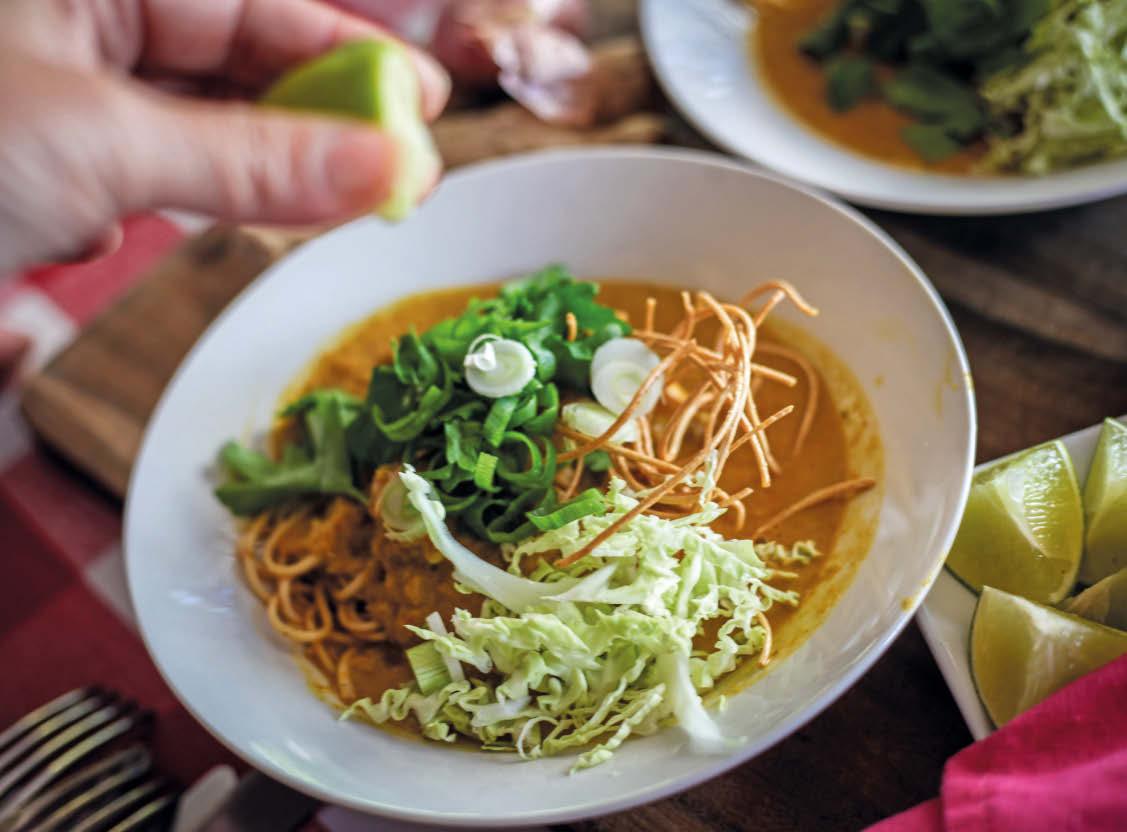


Contents Food as a Window onto Thai Life and Culture 5 Exploring Thailand’s Many Regional Cooking Styles 6 Food Secrets Only the Thais Know About 10 Menu Suggestions 12 Preparing Thai Food at Home 14 How to Make Great Steamed Thai Rice 19 Using Authentic Thai Ingredients 20 AUTHENTIC THAI DIPS AND SAUCES Nam Pla Prik 30 Fish Sauce and its Importance in Thai Cooking 30 Sriracha Chili Sauce 31 The Real Story Behind Sriracha Chili Sauce 31 The Unique Thai–Chinese Approach to Seafood 32 Pravee’s Seafood Dipping Sauce 33 My Dad’s Seafood Sauce (Without Pickled Garlic) 33 Jaew: The Quintessential Isaan Sauce 34 Jaew Chili Sauce 34 How Chilies Have Come to Define Thai Identity 35 Nam Prik Gapi Shrimp Paste Dip 36 Pon Pla Tu Mackerel Salad 37 Nam Prik Kee Ga Dip 38 Nam Prik Tomato Chili Dip 38 Crabmeat “Lon” Chili Dip 39 CHAPTER 1 POPULAR STREET EATS Where the Locals Eat 42 Guaythiew Gai Maraa Chicken Noodle Soup 44 Pad Krapao Basil Stir Fry 45 Grilled Beef Meatballs with Sweet Chili Sauce 46 Thai Sukiyaki 48 The Birth of the Irresistible Thai Hot Pot 49 Drunken Noodles 50 Pad Thai and the Birth of a National Identity Based on Noodles 51 Pad Thai 52 Or Suan Oyster Omelet 54 The Hainanese Chefs Who Saved Siam From Colonization 55 Mee Krob Sweet and Sour Rice Noodles 56 Khao Soy Curried Noodles: A Culinary Fusion Classic 58 Khao Soy Curried Egg Noodles with Chicken 59 CHAPTER 2 BANGKOK AND CENTRAL THAI FOOD The Beating Heart of Thailand’s Cuisine 62 Salmon Marinated in Nam Pla Fish Sauce 64 Tom Kha Gai Chicken Coconut Soup 65 Shrimp in Curry-egg Sauce 66 Jay Fai’s Tom Yum Goong Hot and Sour Soup 67 What is Kapi and Why is it So Revered? 68 Moo Pad Kapi Stir-fried Pork 69 Khao Kluk Kapi Shrimp Paste Fried Rice 70 Sweet Soy Pork 71 Khao Thom Rice Porridge 72 Pickled Cabbage 73 Salted Eggs 73 Fried Lacey Eggs with Thai-style Dressing 74 Simple Stir-fried Greens 75 Thailand’s Fast-developing Drinking Culture 76 Nuea Dat Diew Salted Beef 78 Cashew Nuts Yum 79 The Portuguese Influences in Thai Food 80 Minced Chicken Kanom Jeen 81 Hearty Beef Tongue Stew 82











CHAPTER 3 NORTHERN THAI COOKING Where China, Laos and Myanmar Meet 86 Saa Pak Northern Mixed Salad 87 A Day in the Life of a Chiang RaiMarket 88 Gang Pak Plang Soup with Pork Sausage 89 How to Cook Sticky Rice 90 Pik Gai Tod Baab Fried Chicken Wings 91 Nam Prik Ong Minced Pork 92 Nam Prik Num Roasted Green Chili Dip 93 Gang Gradang Cold Pork Jelly 94 Sai Oua Chiang Mai Sausage 95 Northern Thai Communal Larb Culture 96 Minced Pork or Beef Larb 98 Minced Fish Larb with Herbs 99 Chiang Mai’s Midnight Fried Chicken Restaurant 100 Nam Prik Tha Dang “Red Eye” Chili Dip 102 Moo Tod Fried Pork Cutlets 103 The Story of Thai “Spaghetti” 104 Nam Ngiew Pork and Tomato Sauce Noodles 105 CHAPTER 4 ISAAN CUISINE FROM THE NORTHEAST Influences from Laos and Vietnam 108 Por Pia Tod Spring Rolls 109 Gang Om Lemongrass and Dill Chicken Soup 110 Makuea Mashed Eggplant Salad 111 Pla Rah and its Importance in Isaan Cooking 112 Foolproof Som Tum Pla Rah 113 Som Tum Salad and Its Makeover in the Capital 114 Central Thai-style Fruit Som Tum 115 How the Vietnamese Came to Isaan 116 Moo Yaw Pork Paté 117 The Royal Gift of Tilapia (from Japan) 118 Mieng Pla Pow Baked Fish 119 Kai Kata Egg in a Pan 121 CHAPTER 5 SOUTHERN-STYLE FAVORITES Southern Thailand: “Soldier’s Rations” 124 Yum Woon Sen Glass Vermicelli Salad 125 A Family Food Gathering in Hua Hin 126 Gang Som Southern Fish Curry 127 Why Phuket’s Cuisine is Unlike Any Other 128 Phuket Steamed Fish Balls 129 Hokkien Fried Noodles 130 Moo Hong Braised Pork Belly 132 Phuket-style Fluffy Omelet 133 The Muslim Community in Southern Thailand 134 Thai Oxtail Soup 135 Massaman Curry 136 Thai-style Chicken Biryani 138 CHAPTER 6 THAI DRINKS AND DESSERTS Pioneers of the Sweet and Savory 142 Gluay Buad Chee Bananas in Sweet Coconut Cream 143 Khao Niew Mamuang Mango Sticky Rice 144 Aunt Priew’s Halo Halo 145 A Persian-inspired Family Favorite 146 Kanom Sai Gai Saffron-scented Jalebi 147 Maria Guyomar de Pinha—Thailand’s Escoffier 148 Sankaya Fuk Tong Pumpkin Custard 149 Kanom Pui Fai Cupcakes 150 Coconut Ice Cream 151 Thai Sweet Rolls 152 The Story of the Thai Ice Cream Sandwich 153 Ode to Local Neighborhood Drinks Vendors 154 Thai-style Iced Coffee 155 Thai Iced Tea 155 Morning Ginger Drink 156 Refreshing Lime Soda 156 Thai-style Gin Fizz 157 Thai Cooking Terms 158 Index 158 Acknowledgments 160
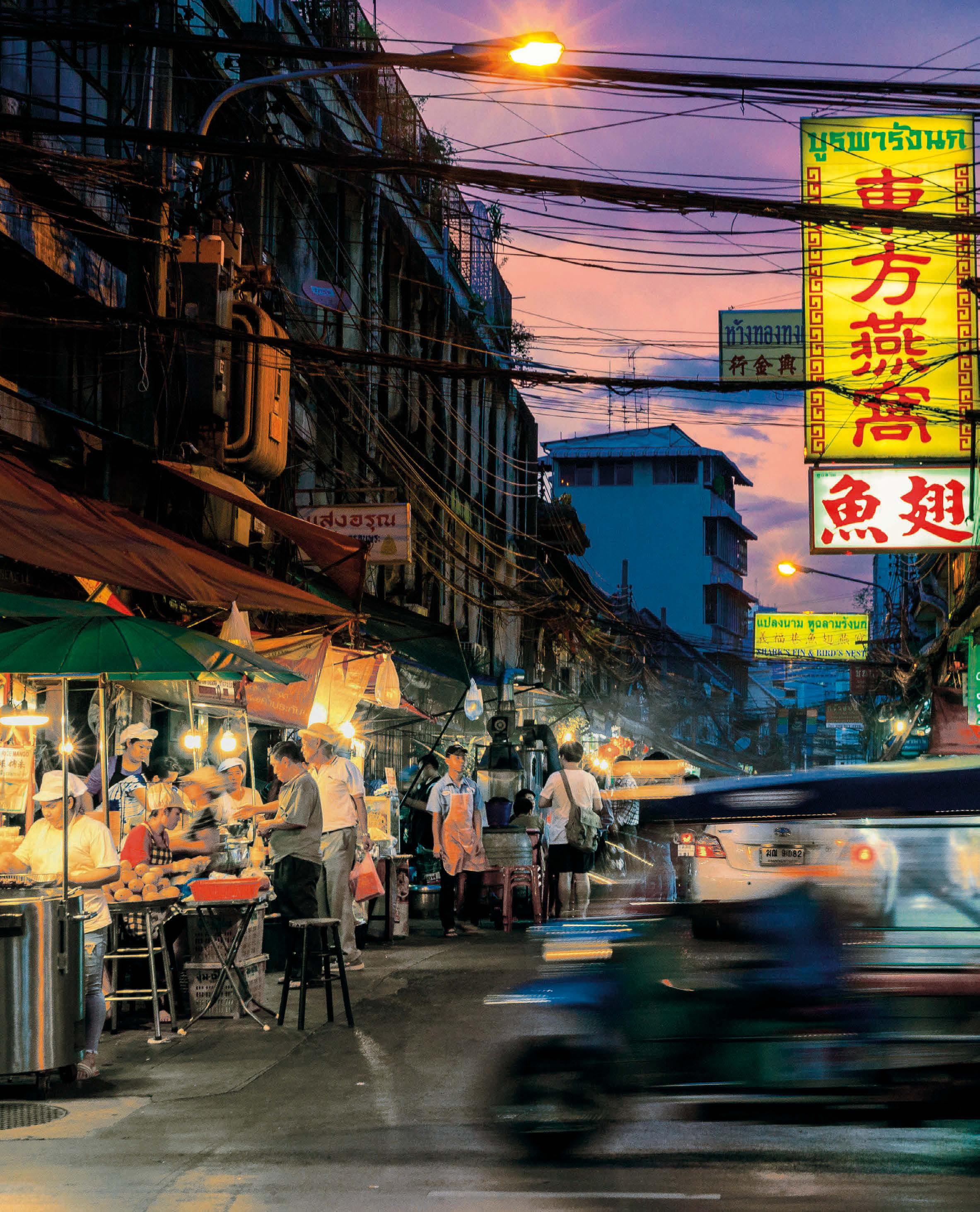

Food as a Window onto Thai Life and Culture
By Chef McDang
Chow and I go back a long long way. When I first met her, I was writing my own English-language Thai cooking bible, the Principles of Thai Cookery. I had written many cookbooks before then, but they were always in the Thai language, and I was wary that a cookbook in the English language would be sapped of all of my personality and sense of humor. Luckily, Chow was able to help me retain my voice in the text, and I could tell that she, too, felt as passionate about Thai cooking as I did. During the many, many hours we spent together while writing—she typing, me relating my recipes and the stories behind them—she was like a sponge, the perfect conduit for absorbing all of the information from my brain onto the page. I am happy to have had such a good pupil of Thai culinary history.
Since then, we have managed to keep in touch. Over the years, as she has written various articles on Thai cuisine, she has asked me very specific and in-depth questions about the history behind the food. I can see that her interest in the cuisine and culture, like mine, is not superficial, and that she truly wants to know the context behind the food that the Thai people eat. In this way, she and I share a similar view of the cuisine, not just simply a way for people to get together and enjoy their lives, but as a mirror
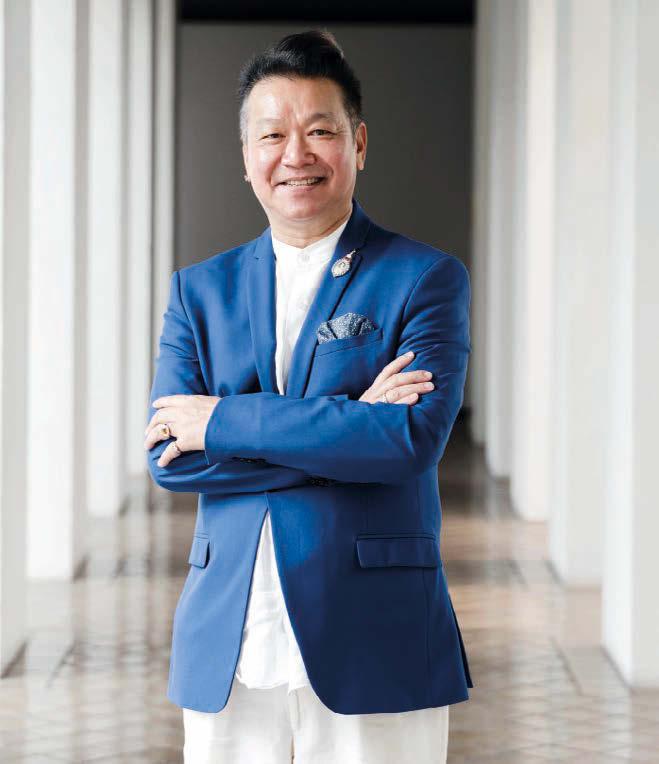
for the historical and social developments of a certain place and time. Thai food is delicious, but each dish is also a piece of history. I think it is important for people who take an interest in Thai food to approach the cuisine through this historical lens, and I know Chow shares the same sentiments.
I am so glad to see that Chow is finally coming out with her own book, which I am sure will be interesting and, at the same time, informative. I have always told Chow that I am a teacher and getting old and there are many ways to impart knowledge of Thai cuisine. I feel that my way of writing is a little stuffy and technical, and I am sure Chow’s book will be a lot more fun and interesting as well as informative. I wish Chow all the success with this book and look forward to reading the whole book.
5
FOOD AS A WINDOW ONTO THAI LIFE AND CULTURE
Exploring Thailand’s Many Regional Cooking Styles
It’s hard to understand from many Thai restaurant menus abroad, but needless to say, not everyone eats green curry and pad Thai on a regular basis. When it comes to food, Thailand is more of a patchwork quilt of regional styles, each part mirroring its own specific influences: China and Burma in the North; Laos in the Northeast; Malaysia and China in the South; and in the central region, all of the foreign influences disseminated by the Palace.
So we will explore Thailand like many have never seen it, region by region. Along the winding mountain roads up North, where travelers by car risk motion sickness when driving from one town to the next, openair eateries abound with minced salads of meats and spices, eaten by hand with fresh leaves gathered in the mountains and bamboo baskets of sticky rice. The rice is meant to be rolled up into a ball, the edible receptacle by which to bring bits of larb or deep-fried pork to the mouth, in a motion known in Thai as pun khao (rolling rice).
Due to the North’s “cooler” climate (of course, everything is relative), meals are of a heartier and, shall we say, meatier disposition. Platters are laden with fried herbaceous sausages known as sai oua, flattened schnitzellike strips of pork called moo pan, and various other iterations of moo tod (deep-fried pork cutlets), which litter tables groaning under mountains of freshly steamed sticky rice. Here, the chicken may be cheap and the buffalo too hard at work to be eaten, but the pig reigns supreme.
Maybe because of its meat-for-
ward diet, the North also tends to harbor much milder dishes, making it one of the less spicy of Thailand’s regions. Even its chili dips—most famously, the nam prik num (roasted green chili dip) and nam prik ong, a Bolognese-like dip flavored with fermented bean paste—fall on the beginners’ end of the spice spectrum, flavorings to augment the pork, bitter forest greens, tart soups, deep-fried pork rinds and sticky rice that form the bulk of Northern Thai cuisine.
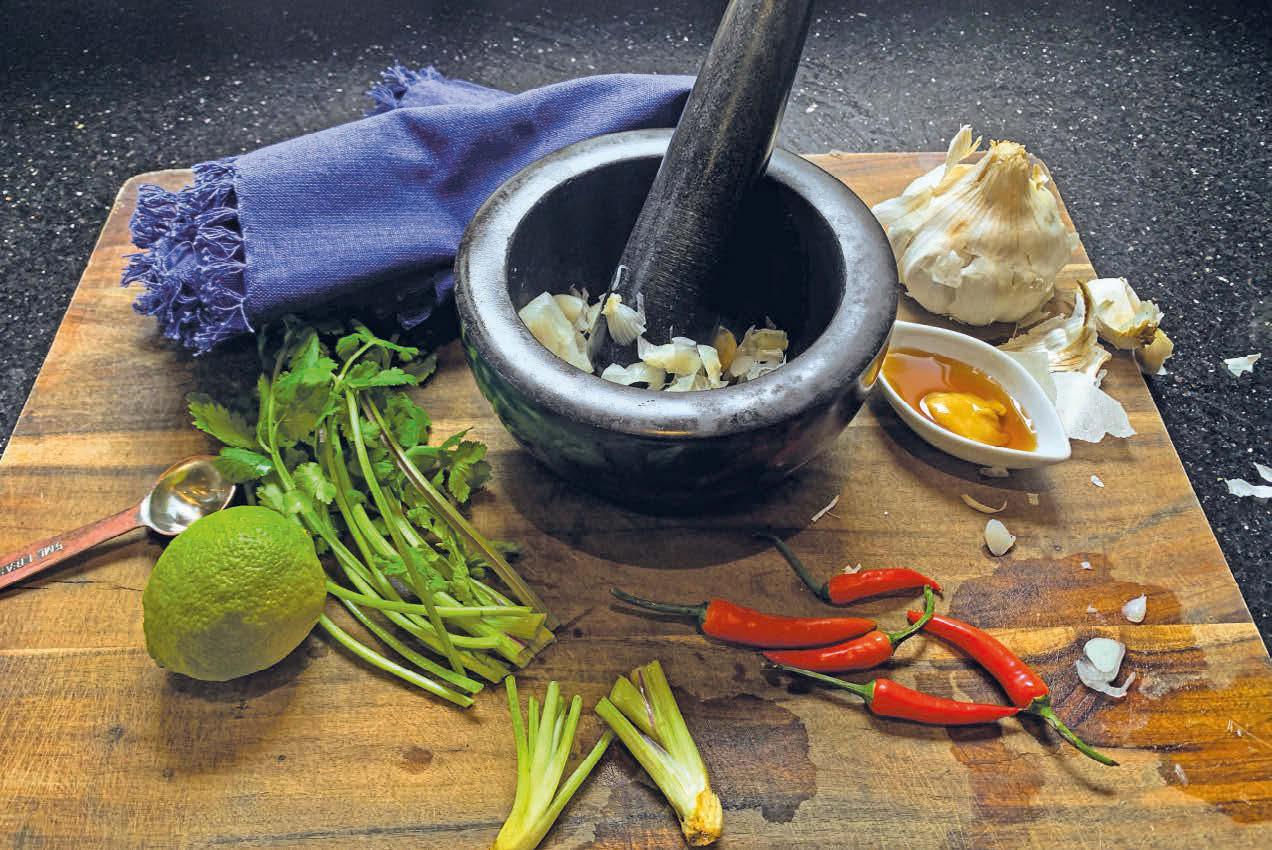
6 REAL THAI COOKING

And bitterness forms the insistent background chatter to the symphony of flavors that make up the food in the North. Marshalled by a plethora of herbs and other greens that grow naturally in the mountains, stews, minced salads, stir-fries and chili dips use the bitterness to highlight other ingredients’ sweetness, and sometimes help that bitterness along with a helpful drop or two of nam dee (pork or beef bile).
The terrain is different in the Northeast, also known as “Isaan.” The land—dusty, dry and rocky— is where the people work hard to scrape a living from the soil. Yet their food is as popular as anything else in Thailand, thanks to its direct, gregarious, and uncompromising flavors: spicy, tart and salty. Isaan cuisine is notorious for its aversion to sugar (something Bangkokians could not possibly live without) and its base of fermented fish known as pla rah. In fact, the saying goes that if it doesn’t have pla rah in it, it’s not really Isaan.
The cooking methods in the Northeast are, for the most part, quick and easy. Isaan people love food, but they also have better things to do. Grilling and boiling are what form the better part of these dishes, but there are also quite a few shredded salads (the most famous of which is som tum), made up quickly in a mortar and pestle. Everything is accompanied by local herbs such as pak chee farang (sawtooth coriander) and pak chee lao
(dill) as well as fresh cut long beans and a spice-fighting wedge of juicy fresh cabbage.
And unlike in the North, the fire in this cuisine is real. Although the staple here is also sticky rice, Isaan food might rank as the second spiciest in the land, incorporating copious amounts of chilies into their dips, salads, stews and sauces. Maybe this is why the Isaan word saap (for “spicy” and “delicious”) are the same.
When I say that Isaan food is the second-spiciest in Thailand, it’s only because the South exists. Think of the spiciest food you have ever had, and then multiply that by 10. While Isaan food may make your nose run and your eyes water, Southern Thai food will set your ears ringing and make your head feel lighter on your shoulders. Southern Thai chefs like to say that their food is the food of the “soldiers” (i.e. cheap). What they mean by that is that the food is so spicy that copious amounts of plain steamed rice must be eaten, thereby filling up the stomach more quickly and cheaply.
The South is known for its seafood, but its history is far richer than that. The bulk of Thailand’s Muslim community calls the South home, and are centered in Thailand’s three southernmost provinces: Yala, Narathiwat, and Pattani, which were once known as part of the Sultanate of Pattani. It was taken over by Siam in 1785 and, since 2001, remains riven by conflict. All the same, the Malaysian influence thrums insistently throughout the region’s cuisine, resulting in the liberal use of turmeric and dried spices.
The South is also host to some of the country’s most vibrant Chinese enclaves. The site of a thriving tin mining industry, places like Phuket welcomed Hokkien Chinese communities to its increasingly wealthy shores, resulting in a number of dishes that cannot be found anywhere else in Thailand. Meanwhile, sizable Teochew communities sprouted in various parts along the Southern Thai coastline, resulting in fusion Chinese-Thai treatments of seafood—steamed fish in soy sauce, shellfish baked with glass vermicelli—that have become key components of the mainstream Thai
7 EXPLORING THAILAND’S MANY REGIONAL COOKING STYLES
menu today. Let’s not forget the invention of a littleknown sauce called Sriracha, named after a Southern Thai coastal town. Although Americans may be familiar with a Vietnamese-American version of the sauce, the inspiration for that sauce is Chinese-Thai: tart, spicy and sweet, brewed from chilies aged in the sun.
Surprisingly, it’s in the central region where we may find the most revelations. Yes, we all know about pork satay and chicken with cashew nuts. We’ve had plenty of massaman curry and fried rice in a pineapple. But there are dishes that have been carved out of the region’s unique history that few casual diners really know.
Known as the “rice basket” of the country, the verdant Central region is incredibly fertile, spawning papayas, bananas, pineapples, limes, and of course rice with ease. Indeed, this region is so fertile that it has formed part of the Thai national identity; one of the first inscriptions in the Thai language reads: “In the time of King Ramkhamhaeng the Great, this land of Sukhothai is thriving. There is fish in the water and rice in the fields.” This inscription, one of the oldest discovered so far, fuels the belief that as long as rice continues to grow and fish continue to swim, Thais will never go hungry.
The northern reaches of the region, home to both Sukhothai and Ayutthaya, another of the kingdom’s former capitals, boast abundant access to limes, palm sugar, tamarind and fish, dictating a flavor profile that today is considered distinctly Thai. Sweet, spicy, tart, salty, umami and a little bitter, the coexistence of these tastes on one spoon is called rot grom (rounded flavors) in Thai. These are the flavors that have traveled worldwide and made Thai cuisine famous.
Meanwhile, Thailand has shown a unique talent for incorporating whatever foreign influences reach it, tweaking them, and assimilating them into something completely different and ultimately Thai. In the age of the Sukhothai and Ayutthaya kings, foreign envoys from lands as far-flung as Portugal and Persia brought with them chilies, corn, and peanuts—ingredients that would one day be wholeheartedly associated with Thailand. Shrimp paste and fish sauce arrived courtesy of Arabic traders or Chinese merchants, depend-
ing on which food historian you talk to. A foreign cook by the name of Maria Guyomar de Pinha even came to work in the palace, bringing with her new cooking techniques like steaming flour “cupcakes” for desserts and new ways of using common ingredients like eggs. Instead of blocking off these influences, Thailand welcomed them with the knowledge that they would take on a Thai twist in time.
Since then, Thailand’s most recent capital, Bangkok, continues to host culinary innovations of its own. An influx of Chinese immigrants in the mid-1800s to mid-1900s led government authorities to engineer their own ways to turn typical “Chinese” ingredients like noodles into something more closely resembling Thais’ views of their own food. This directly led to dishes like pad Thai. Even when left to flourish on its own, Chinese influence on Thai cuisine—woks, frying, deep-frying, duck meat—eventually took on distinctly Thai identities, leading to fusion dishes as varied as pad see ew (noodles stir-fried in soy sauce) and gang phed ped yang (grilled duck red curry). Today, the traditionally “Chinese” dishes enjoyed by Thais like khao thom (rice porridge), joke (rice congee), soup noodles and dim sum have taken on flavors and garnishes that actual Chinese diners would find bizarre.
Of course, a discussion of Chinese influence on Thai food cannot be complete without touching on street food. Chinese workers who came to Thailand found themselves shut off from traditional avenues of employment like the civil service, forcing them into lower-paying jobs like construction. Because their homes were too small to allow them to cook in, they resorted to eat outside—resulting in rudimentary restaurants. Soon, food hawkers devoted their time to working the waterways that once criss-crossed the city, offering dishes once available in their hometowns, like soup noodles. Street food in Thailand was born.
While culinary innovations once emanated from the royal palace and the cooks who hosted its many foreign envoys, much of the inspiration for Thai food now arguably comes from the streets. Because of the low threshold involved in setting up a stall, it is the street that now sniffs out prominent trends like Japanese takoyaki or Korean galbi, fashioning them into
8 REAL THAI COOKING
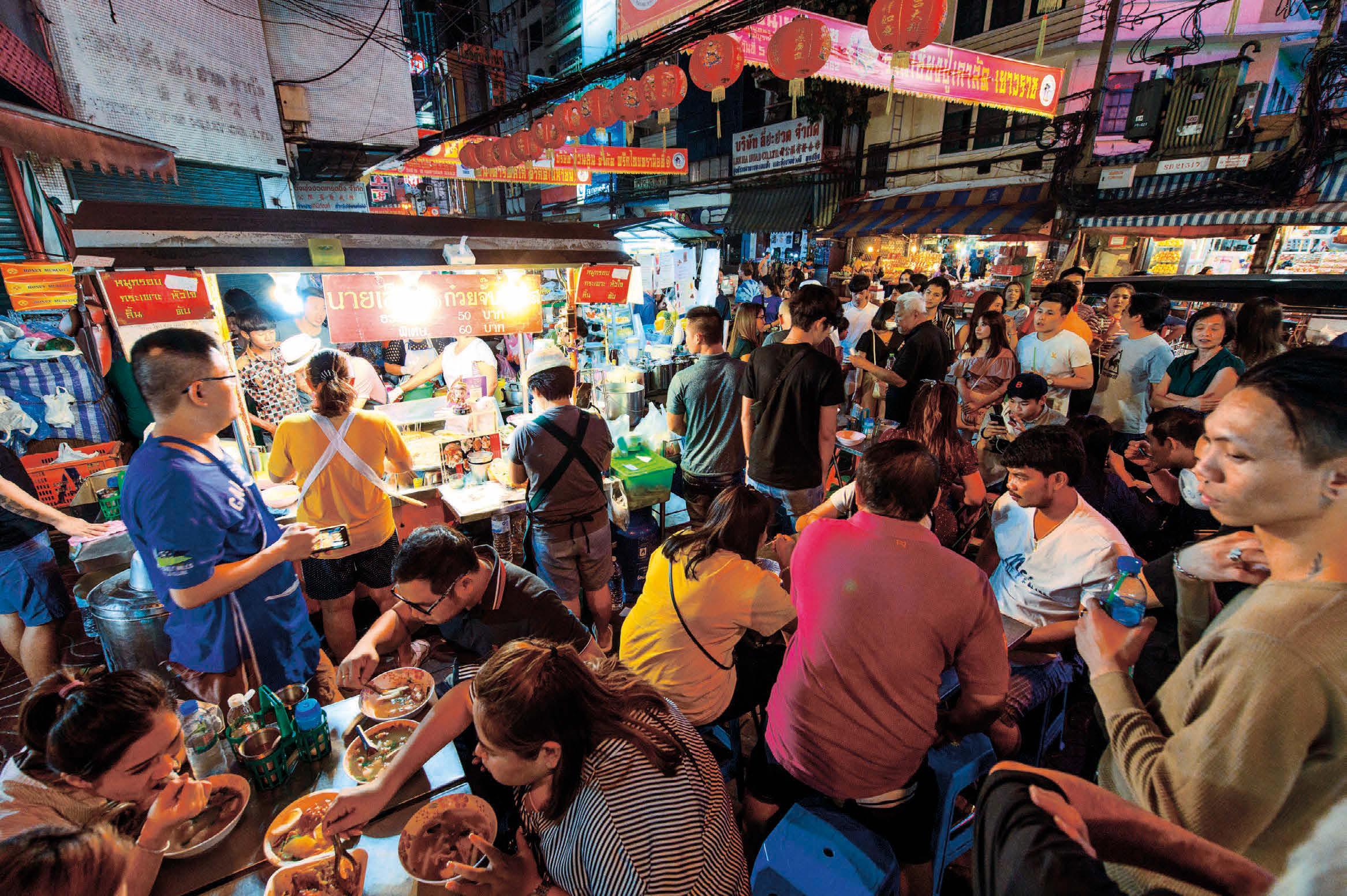
dishes palatable to Thai tastes. Recent attempts to curb street food—arrested by the current COVID outbreak—have threatened to upset a delicate ecosystem that not only benefited the Thai food scene, but the wallets of ordinary working Thais who make up a bulk of the city’s workforce.
Today, Bangkok’s Chinatown (also known as Yaowarat) is considered the spiritual heart of Thailand’s street food scene, even if street food can (even now) be found on almost every corner. Chinatown is now a big business, hosting food tours and throngs of tourists, as well as nostalgic Bangkokians eager for a taste of their childhood. It is even the site of something of a food and drink renaissance, its picturesque qualities the perfect setting for new restaurants and bars seeking to refocus on Thai and Asian identities. Even with all of the upheaval that the world has undergone, innovation is burbling away in some Yaowarat alleyways.
Going forward, Thailand, like everywhere else, faces challenges it hasn’t encountered before. The rapid pace of change wrought by the Internet, easy travel and global businesses have made cultural change seem out-of-control, leading to strange government decisions like the recent attempt to build a “Thai food tasting robot” to keep the standard taste of every Thai dish served in a restaurant the same.
Maybe not surprisingly, this met with less success than the cooking contest that led to pad Thai. All the same, globalization has also led to the drive to learn more by encouraging more home cooking and the placing of recipes in their proper historical and cultural contexts.
If this cookbook succeeds even a little bit in that, this jaded food writer will have considered herself blessed with plenty of rice in the field and fish in the water.
9
EXPLORING THAILAND’S MANY REGIONAL COOKING STYLES
Food Secrets Only the Thais Know About
I was eight when I started cooking, and it was out of necessity. My father was normally the cook of the family, but as a pediatrician, he didn’t get off work until eight at night, and that was sometimes too late for me. My mother’s attempts at cooking were rare and better off forgotten, for both her and for us. If I was hungry and wanted to eat, I would have to do it myself.
We only had one cookbook, a well-worn tome from the 1970s full of recipes for aspics and salads suspended in jelly. But there were also important basics that formed the building blocks for what I grew to love about the act of cooking itself: the patient stirring of a sauce as it thickens, the layering of flavors and aromas in the pot, the selection and preparation of fresh ingredients perfectly suited to a dish.
When it came to writing my first cookbook, I wanted to translate that kind of love for food into my own pages. Because Thai food is so complex and varied, I imagined it would be a difficult task to undertake. But the truth is, the love of the food isn’t hard to communicate. Thais, at their very heart, love their cuisine. For centuries, it has been the way for Thais to share between friends, to bond with wouldhave-been enemies, or to catch up with loved ones. “Kin khao la yang?” (“Have you eaten yet?” or, more accurately, “Have you eaten rice yet?”) is still a common greeting. And even in the age of COVID, Thais still manage to share stories and jokes over a common meal, even if it’s over the computer.
But make no mistake: COVID had a big impact on our lives here in Thailand, making it much harder for people to make those culinary connections face-toface, to learn from each other over a shared countertop, or to laugh over kitchen disasters with a bottle of beer. All the more reason, then, for something like this cookbook—a part of Thailand that you can craft in your own kitchen. It might not be exactly like what you would find in Thailand, but that doesn’t really matter. Honestly, I can’t imagine something more Thai than taking a piece of Thailand and spinning it for yourself.
The fact is, the “secrets” promised above are things that everyone probably already knows. Let’s face it: there are people who like to cook, but who are lazy. They are my brethren. But a desire to take things easy doesn’t automatically mean the food will be bad. The “secrets,” if you can call them that, are that good cooking comes from the heart. That what you attempt isn’t always going to work. That there will be days when you just don’t feel it, and that it’s alright if that’s the case. But if the love is always there, your explorations in the kitchen ultimately will not be in vain.
That said, there are rules that govern most Thai dishes. They remain rules that most Thais follow, even today. They are:
■ Thais only cook with unscented oils like vegetable, peanut and canola. That’s because, like a chef averse to a strong cologne, no one wants to
10 REAL THAI COOKING

fight through competing smells which will mess with their perceptions of taste, and the aromas for each dish are already strong.
■ Thai food is served at room temperature, which probably seems odd to Westerners who prize hot food. This is because Thailand is a hot place.
■ Thai food is served in bite-sized pieces, so there is no need for a knife at the place setting. Instead, diners eat with a fork and spoon. Food is served family style, with everyone partaking of the same large platter, with a central serving spoon for each dish.
■ I’ve heard concern for “texture” thought of as an Asian thing. I find that a strange generalization. But if you are thinking that a “crunch” element is usually included in Thai cuisine, you would be right.
■ Thais always cook on the bone, for more flavor. The decision to remove the bones before serving is up to the chef; I for one welcome it. There is nothing worse than biting down on a large juicy piece of fish in a nice tom yum and getting stabbed in the gums by a fish bone!
11
FOOD SECRETS ONLY THE THAIS KNOW ABOUT

Menu Suggestions
These are some possible dinner menus that you can craft using the recipes in this book. You can either serve them in courses, as detailed below, or you can serve the appetizers and mains at the same time, family-style, with dessert after, like most of us do in Thailand. I’d suggest the best drink to go with these menus is beer (maybe even beer that’s been left in the freezer until it’s slushy, called beer woon), but Riesling and Gewurtztraminer are traditionally the wines said to go best with Thai food.
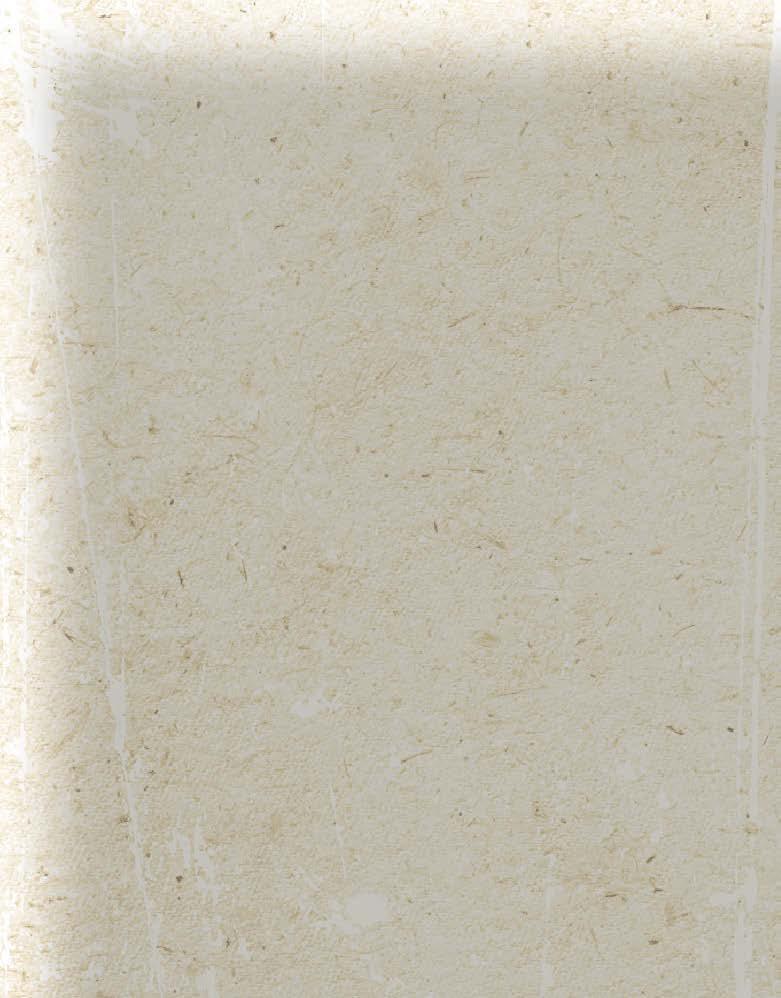

MENU 1
Thailand’s Greatest Hits
APPETIZERS
Por Pia Tod Spring Rolls (page 109)
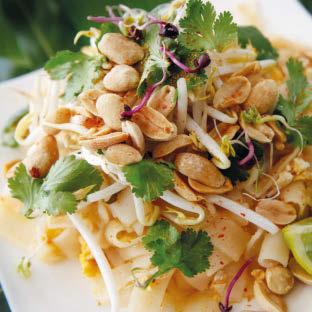
Tom Kha Gai Chicken Coconut Soup (page 65)
Fried Lacey Eggs with Thai-style Dressing (page 74)
Central Thai-style Fruit Som Tum (page 115)
MAINS
Pad Thai (page 52)
Khao Soy Curried Egg Noodles with Chicken (page 59)
Massaman Curry (page 136)
Steamed rice
DESSERT
Khao Niew Mamuang Mango Sticky Rice (page 144)

MENU 2
An Isaan Feast
APPETIZERS




MENU 3
Street Food Favorites
APPETIZERS
Tom Yum Goong (page 67)
Or Suan Oyster Omelet (page 54)

Grilled Beef Meatballs with Sweet Chili Sauce (page 46)
MAINS
Pad Krapao Basil Stir Fry (page 45)
Drunken Noodles (page 50)
DESSERT
Coconut Ice Cream in Sweet Rolls (page 151)
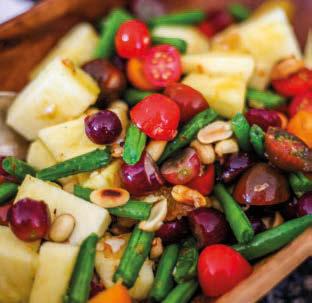
Foolproof Som Tum Pla Rah (page 113)
Makuea Mashed Eggplant Salad (page 111)
MAINS
Gang Om Lemongrass and Dill Chicken Soup (page 110)
Mieng Pla Pow Baked Fish (page 118)
Grilled chicken with Jaew Chili Sauce (page 34)
Sticky Rice (page 90)
DESSERT
Fresh fruits like mango, pineapple, rose apple, and oranges

MENU 4
Northern Thai Sampler
APPETIZERS
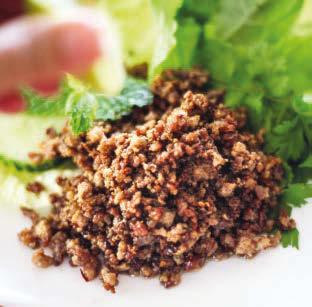
Saa Pak Northern Mixed Salad (page 87)
Nam Prik Ong Minced Pork dip (page 92)

Nam Prik Num Roasted Green Chili Dip (page 93)
Deep-fried Pork Rinds (page 131)
MAINS
Minced Pork or Beef Larb (page 98)
Pik Gai Tod Baab Fried Chicken Wings (page 91)
Nam Prik Tha Dang “Red Eye” Chili Dip (page 102)
Sai Oua Chiang Mai Sausage (page 95)
Sticky Rice (page 90)
DESSERT
Aunt Priew’s Halo Halo (page 145)




MENU 5
A Retro Thai Meal
APPETIZERS
Nam Prik Kee Ga Dip (page 38)

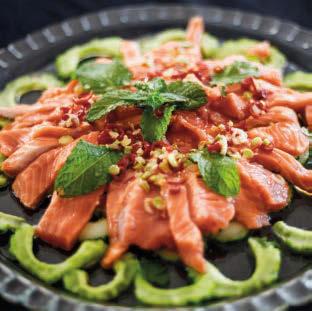
Salmon Marinated in Nam Pla Fish Sauce (page 64)
Gang Som Southern Fish Curry (page 127)
MAINS
Hearty Beef Tongue Stew (page 82)
Mee Krob Sweet and Sour Rice Noodles (page 56)
Steamed rice (page 19)
DESSERT
Gluay Buad Chee Bananas in Sweet Coconut Cream (page 143)

MENU 6
Southern Thai Seafood
APPETIZERS


MENU 8
An Easy Thai-Themed Party (things you can prepare easily ahead of time except for Som Tum)

Tom Kha Gai Chicken Coconut Soup (page 65)
Fried Lacey Eggs with Thai-style Dressing (page 74)
Shrimp in Curry-Egg Sauce (page 66)
Moo Tod Fried Pork Cutlets (page 103)
Minced Fish Larb with Herbs (page 99)
Simple Stir-fried Greens (page 75)
Foolproof Som Tum Pla Rah (page 113)
Aunt Priew’s Halo Halo (page 145)


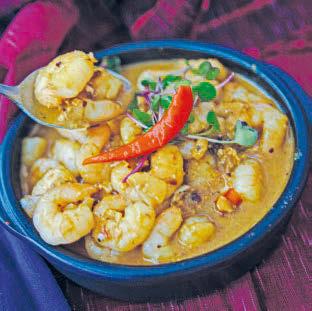
Nam Prik Gapi Shrimp Paste Dip with Eggy Eggplant and Moo Gon Pork Meatballs (page 36)
Yum Woon Sen Glass Vermicelli Salad (page 125)
Thai Oxtail Soup (page 135)
MAINS
Steamed seafood with Seafood Dipping Sauce (page 33) or Seafood Sauce without Pickled
Garlic (page 33)
Shrimp in Curry-Egg Sauce (page 66)
Steamed rice (page 19)
DESSERT
Kanom Sai Gai Saffron-scented Jalebi (page 147)
Fresh fruits

MENU 7
When You’re Hung Over
Khao Thom Rice Porridge (page 72)
Pickled Cabbage (page 73)
Salted Eggs (page 73)
Fried Lacey Eggs with Thai-style Dressing (page 74)
Simple Stir-fried Greens (page 75)




MENU
9
A Meal I’d Eat Anytime
APPETIZERS
Yum Moo Yaw Pork Paté (page 117)
MAIN
Thai Sukiyaki (page 48)
DESSERT

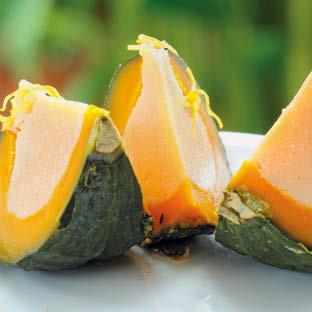
Sankaya Fuk Tong Pumpkin Custard (page 149)
MENU 10
New Year’s on the Beach
APPETIZERS
Cashew Nuts Yum (page 79)


Nuea Dat Diew Salted Beef (page 78)
Pon Pla Tu Mackerel Salad (page 37)
MAIN
Thai Oxtail Soup (page 135)
DESSERT

Guaythiew Gai Maraa Chicken Noodle Soup (page 44)
Thai-style Chicken Biryani (page 138)
Kanom Sai Gai Saffron-scented Jalebi (page 147)

Kanom Pui Fai Cupcakes (page 150)
Coconut Ice Cream (page 151)



Preparing Thai Food at Home
In the olden days, Thai kitchens were outdoors, placed more than a few steps away from the main living quarters. Anyone who has inadvertently wandered past a cloud of holy basil stir-fry in the making knows the reason why. For Thai cooking to work, the aroma has to make your eyes water, make you cough, cling to your hair, linger on your clothes. This is probably why, even today, many Thai apartments saddle their kitchens with the worst views, because the assumption is the tenant won’t be spending much time there. Unless, of course, they, like me and probably
like you, are the types of masochists who want to cook Thai food.
At its heart, Thai food was meant to be a labor of love. Kati (coconut milk) was not poured out of a can or simply squeezed from a husk; the flesh had to be scraped from the inside with the help of a bench outfitted with a blade on the end called a krathai (rabbit coconut grater).
A cook sat astride the bench (unless she was a true lady, which meant she sat side-saddle because a lady must never spread her legs).
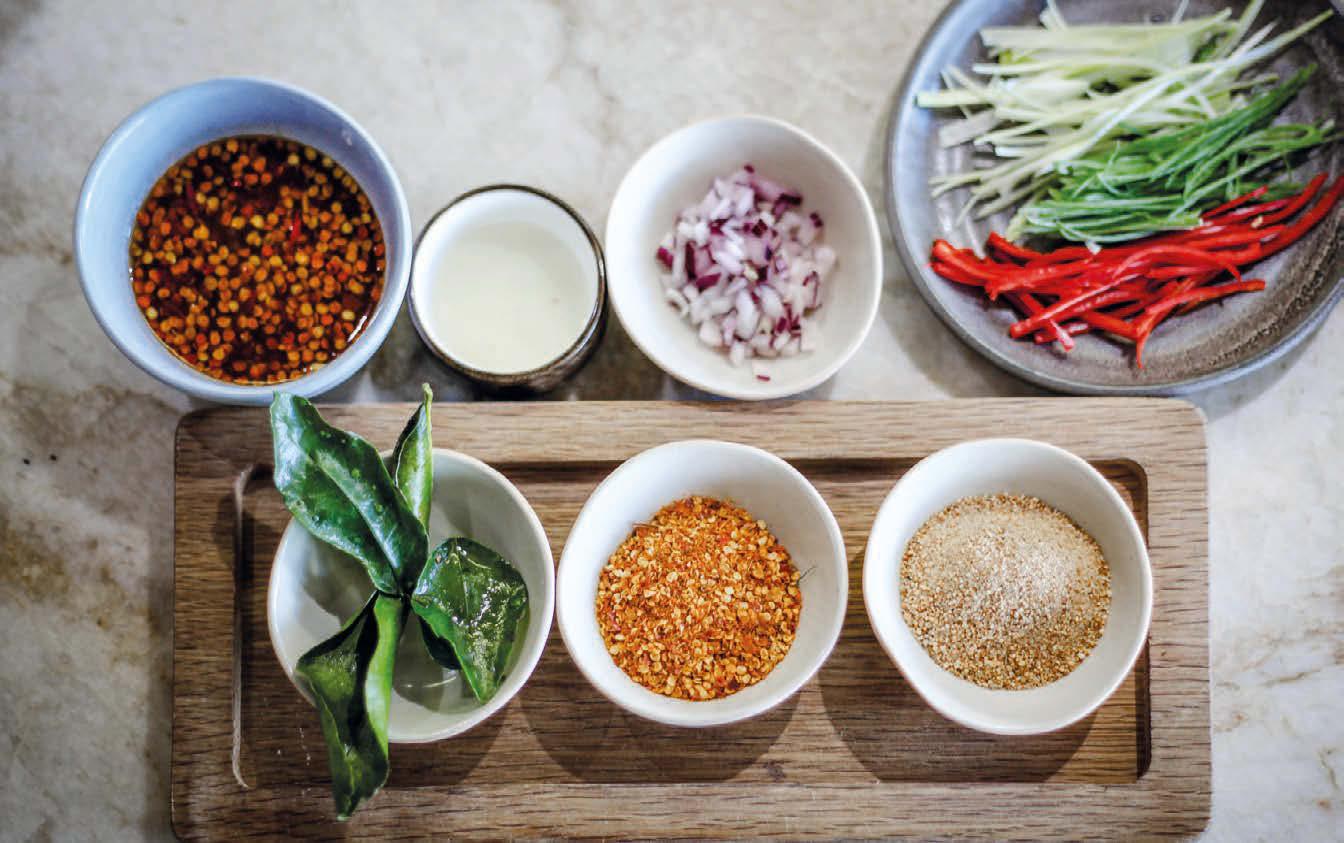
This bench helped her to efficiently scrape the inside of the coconut shell with the blade, a bowl placed underneath on the floor to catch the shredded flesh. The bits of flesh were then gathered in a cloth and squeezed; the first press yielded the hua kati (coconut “head,” or cream). Water is then added to the second squeeze, yielding hang kati
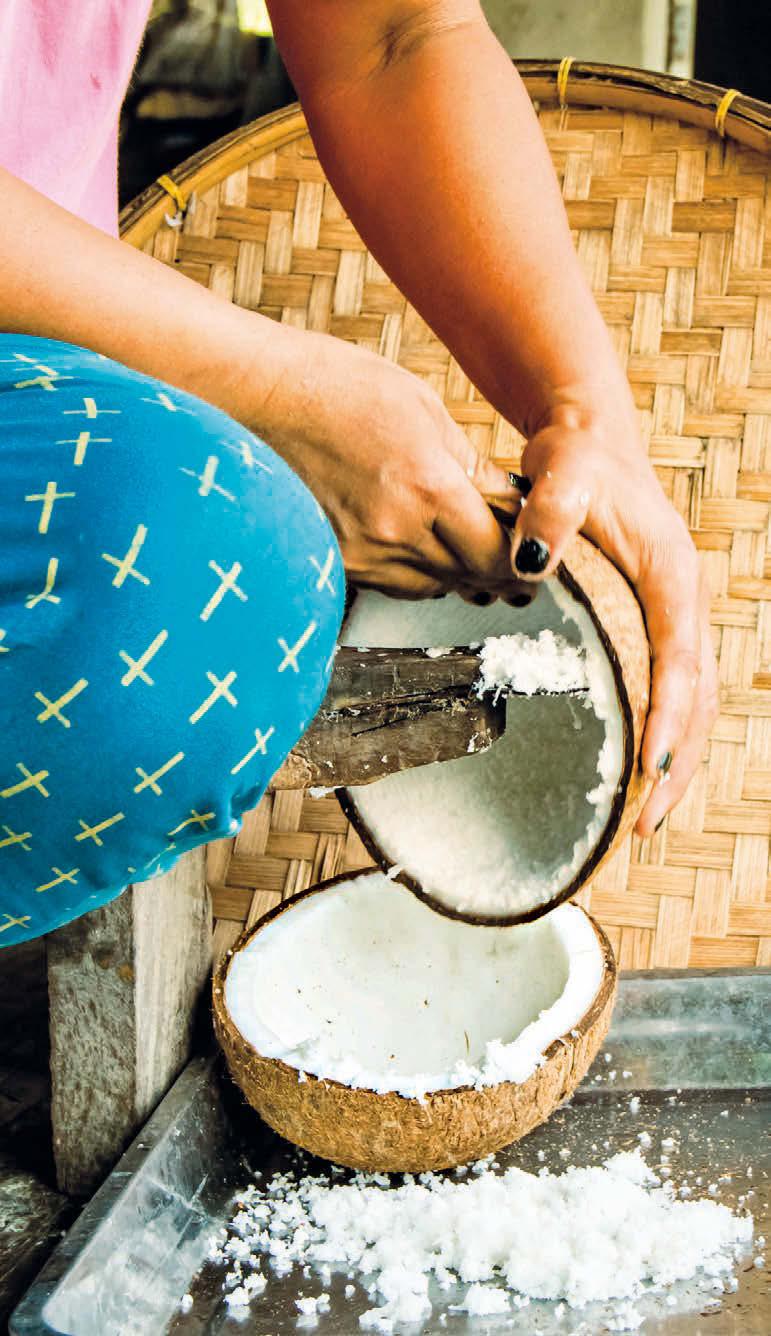

14 REAL THAI COOKING
(coconut “tail,” or milk). Needless to say, it was arduous, timeconsuming work. And that was just the one ingredient. Today, we are blessed to be able to buy our coconut milk at the market, or to shred our coconuts ourselves with the help of machines.
The All-important Spice Paste
Many of the spice ingredients in a Thai recipe are pounded into a paste—the foundation of Thai cuisine. Pastes form the base for soups and curries, chili dips, marinades, some stir-fries, and even some salad dressings. Commonly made with fresh herbs, they are the reason why Thai food boasts that extra oomph in flavor, unlike the heaviness of many other Asian cuisines. But to make those pastes, cooks need access to the number one tool in the Thai kitchen: the mortar and pestle.
Krok sak (mortar and pestle) are ancient cooking tools used in many cuisines. Thailand is no different. However, different sets accom-
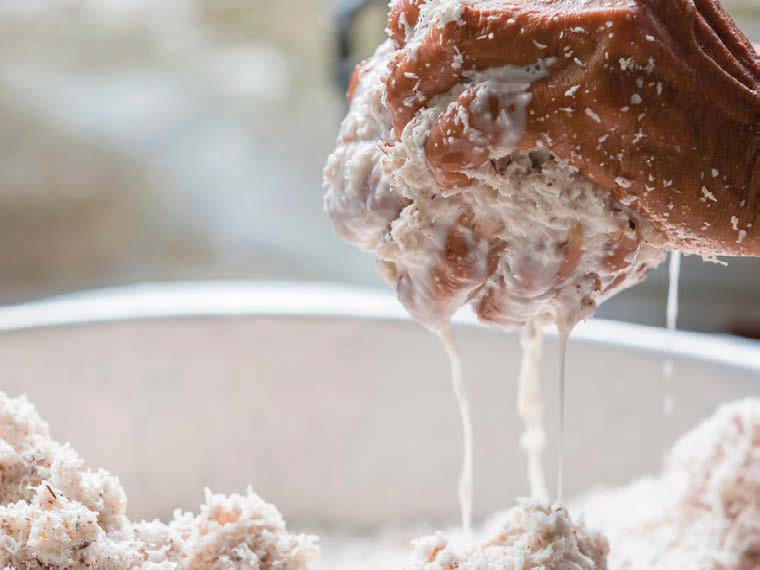
plish different tasks. Mortars and pestles made of granite are good for pounding pastes for curries and chili pastes, but would bruise the delicate components of a som tum (grated salad) too much. For that dish, sets of wood, preferably carved from something aromatic like a mango tree, are the most prized. Like an old omelet pan, the more often a mortar and pestle is used, the more valuable it becomes.
Because the preparation of a traditional Thai meal was so timeconsuming, residential streets and village pathways were alive with the sound of a rhythmic thwackthwack-thwacking from the early afternoon onwards. It is even said that men chose their prospective brides by the loud, swift sounds that their mortars and pestles made as they worked, so important was the role that a Thai meal played to a family.
I have been told that Thai cooks can be gentle and smiley all they like, but that the kitchen is where all that pent-up aggression must
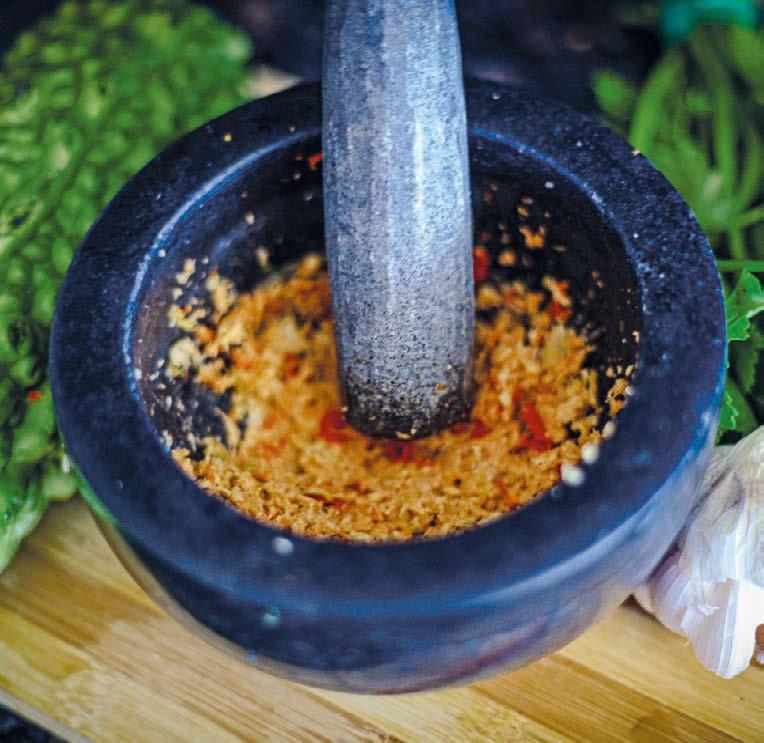
be allowed to run riot. I once read a profile of boxer Mike Tyson that said he hit his opponents, not just with the intention of winning, but to also cause harm. In this case— and only in this case—the Thai cook in the kitchen is Mike Tyson, mashing those paste ingredients into oblivion.
Eyes Beware
Of course, all that aggressive mashing will result in an unexpected problem once you start: protecting your eyes and face from flying chili debris. This is why many cooks prefer to fold a kitchen towel underneath the mortar to increase stability, and to keep the whole setup from moving unexpectedly beneath you as you set to work. You can also obscure the part of the opening of the top with your other hand as you pound, like watching a horror movie through your fingers when it gets to a particularly suspenseful part.
Ultimately, you can never really protect yourself from the chili spray, apart from wearing glasses or putting on ski goggles. I am never thrilled when a bit of chili ricochets into my eye, but I have come to enjoy the tingly sensation the chili liquid leaves on the rest of my face; it’s a bit like my nightly exfoliating toner. I like to imagine that, besides being delicious, chili liquid has similar skin-enhancing effects.
Now, you may be wondering to yourself, “Why can’t I just use a blender and not have to worry about chili juice in my eye?” to which I would respond, “You to-
15 PREPARING THAI FOOD AT HOME

tally can use a blender and not worry about chili juice in your eye.” However, I firmly believe you would also miss out on many of the aromas that are released when you simply buzz everything up in a blender, where everything is chopped up very finely, but not mashed so that the essential oils are blended into the pulp.
The Krok and the Khao
The mortar and pestle are what ensure that not only does a delicious mash ensue from all your efforts, but that the mash will also smell the way it should—fantastically pungent. After all, there’s a reason why David Thompson’s restaurant Aksorn, which sports an open kitchen, resounds with the thumthum sound of various mortars and pestles at work while you are enjoying your meal. Sticklers for Thai
food (and David Thompson certainly is one) want to make their food properly, and that is not really achievable without a mortar and pestle.
Of course, one cannot have a Thai meal without rice. Yes, noodles have taken on a major part of Thai cuisine, but when it comes to the all-important evening meal, traditional Thais still consider rice as the most important part. In the olden days, rice was cooked in

a large steamer set over a pot of boiling water. Happily for us, one of the great technological advances for the Thai home cook has been the maw hoong khao (rice cooker), which takes all of the guesswork out of making a nice bowl of khao hom malee (fluffy, aromatic jasmine rice). One only needs to make sure that the rice is not overcooked; jasmine rice grains tend to get ragged and blowsy at the edges like overgrown weeds when that has happened. But in the event you
are without a rice cooker, do not despair. At the end of this chapter, we will explore a sureproof, rice cooker-less way of cooking rice. There are some types of rice that do not take well to the rice cooker. One of the most glaring examples is sticky rice, prevalent in the North and Northeast of the country. Instead, these cooks use a huad, a woven bamboo basket with a pinched bottom that fits over a wide metal cylinder with a big flaring lip, which is filled with a few inches of water and set over heat.
Get a Weave and a Wok
The slightly open weave allows the grains to be cooked, while still enabling them to breathe. It is imperative that they do not get too hard and sticky, but also not too mushy and gluey. Cooking sticky rice is actually a bit of a tightrope walk, involving more steps than you would expect. In the Northern Thai section, we will discover the best way to ensure perfectly glutinous rice, every time.
To keep that sticky rice in good shape at the table, you need a woven bamboo basket called a gratib, which has the same slightly open weave as the huad. This keeps the grains moist. Unlike white jasmine rice (khao suay, or “beautiful rice”), sticky rice can get hard when kept in a big bowl on the table, as the open air dries the grains out. The gratib, which has a cover, keeps the steam trapped; important because hard sticky rice grains can be unpleasant, especially if you
16
REAL THAI COOKING
are eating spicy food.
Another imperative of Thai cuisine is the stir-frying and frying that have become such a mainstay of the menu. Grata (woks), hatshaped skillets with high sides that spread out from the base, are meant to withstand high heat and enable the easier tossing of the ingredients in the pan. Originally brought to Thailand by the Chinese, woks have now been incorporated as an integral piece of equipment in any Thai kitchen.
First-timers to wok cooking first need to clean their woks thoroughly before using them. This is because many manufacturers coat their woks with a protective oil to keep them from rusting when they are being shipped.
Next comes the seasoning of the wok. This helps your wok develop a natural non-stick quality, improving its performance each time you cook. To start the seasoning, heat the wok’s surface over high heat, making sure to cover all areas of the surface (if you have wooden
handles, cover with foil so they don’t burn). The metal might smoke and change color as you heat it, which lets you know that it’s actually working. Once you’re done, allow the wok to rest for about 1530 minutes.
Next comes the moment when you have to oil your wok. Use an unscented oil with a high smoking point (like canola) and use a paper towel to smooth the oil over the inside and outside of your wok. Keep the layer thin. Then once again heat your wok, making sure to cover the surface and waiting until the oil stops smoking to finish the heating process. When you see the surface become matte, you have successfully seasoned that part of the wok.
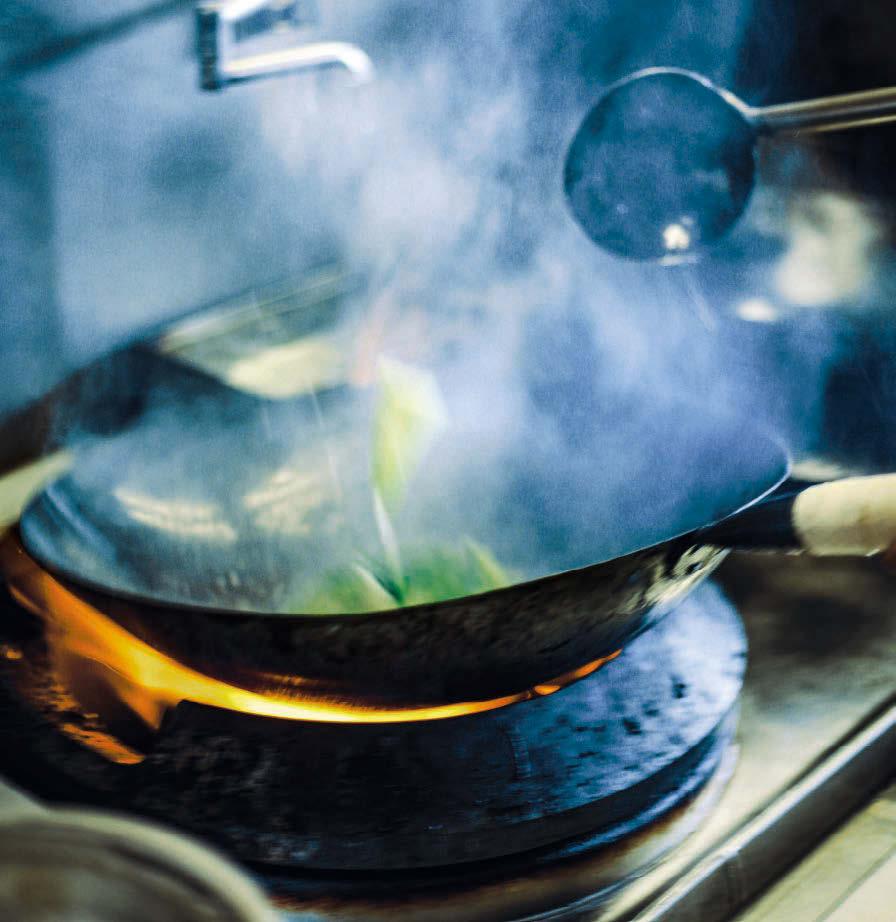
Once you’ve finished, run your wok under hot water one more
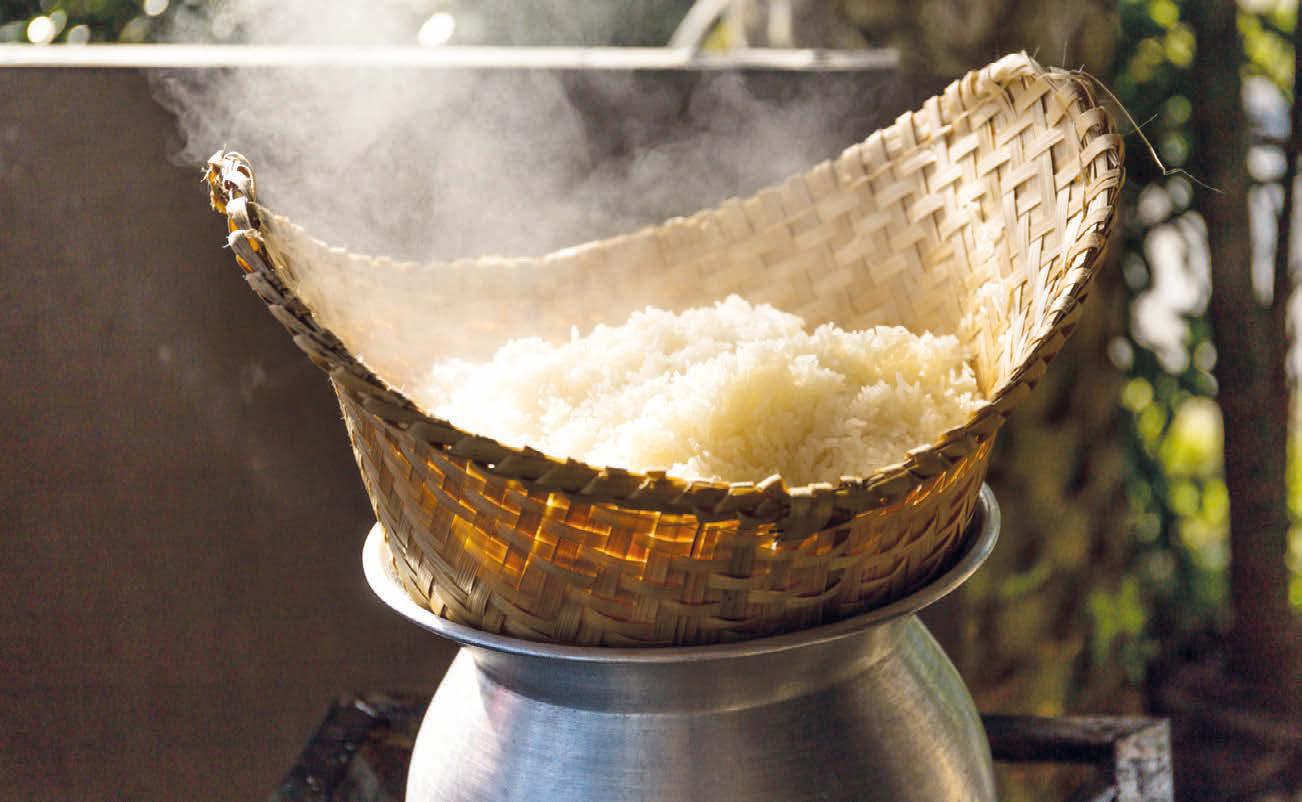
time and clean the inside carefully without scraping off all of the seasoning you’ve done. Then, instead of wiping your wok dry with a dish towel, put it over the stove burner one more time to heat the wok in order to evaporate the water away. You can repeat the entire process one or two more times if you are the type of person who likes to do three reps of everything in the gym. Otherwise, you can now finally put your wok away or use it to make something. From now on, you will be washing your wok with hot water and a sponge (but not with a wire brush or soap).
Tools of the Trade
After the wok, the meed (knife) is the next important part of the Thai cook’s arsenal. However, Thai chefs do not see their knives the same way that Western chefs do. In the West, chefs are in charge of their own knives, sharpening them, collecting them, making them ex-
17 PREPARING THAI FOOD AT HOME
tensions of the chefs themselves. In Thailand, knives are more of a communal thing, shared in the kitchen to use (or abuse) as that particular person sees fit. The theory behind this differing philosophy is that in the olden days, metal for knives was precious, saved for weapons of war. This is why Thai cooks—like many other Asian chefs—can make do with a single battered eeto (butcher’s cleaver) if need be. Indeed, a cleaver can be used from chopping through bonein pork parts to carving julienned pieces from a green papaya.
No Weapons at the Table
In spite of the tendency for Thai cooks to go through knives at a relatively rapid rate, they remain important tools in the kitchen. Food is always cut into bite-sized pieces before it is brought to the diner (there is a lack of personal cutting knives at the table, possibly because of the reason delineated above), thereby ensuring it is easy to eat with rice, spoon and fork. Because plates are communal and meals are family-style, bite-sized pieces also make it easy to share. With knives assuming such im-
portance in the kitchen, kieng (cutting boards) are obviously prime considerations as well. For many cooks, the most prized cutting boards to obtain are those made of tamarind wood, which is considered so strong that Thai butcher’s countertops are often made of it. Thais also believe they impart a tangy “flavor” to the ingredients cut on them and that fat and grease from the meats are eventually absorbed by the wood, making it stronger.

Tamarind trees are still abundant in Thailand because, in the olden days, Thais planted them wherever they went. Their fruit pods are eaten and their pulp incorporated into sauces and soups. Older trees that are not able to supply this fruit become prime candidates for the cutting board.
Because of their size, old trees can yield many boards. Those

boards are known for being very durable, lasting for years if not decades. However, increasing demand has led to young tamarind trees now being used for boards, and because of their sap, the wood is susceptible to fungus. In order to protect your tamarind cutting board from fungus, sprinkle salt over the board to soak up the damp in the wood. Some Thai cutting board manufacturers sell their boards already “pre-salted” or treated in brine.
Cooking with Steam
The last item that may prove indispensable to the Thai home cook is the maw nung (stainless steel steamer), used to cook everything from a whole fish in lime juice and chilies to a pumpkin stuffed with coconut custard. Steaming is one of the more important cooking methods in Thai cuisine, alongside grilling and frying, and is particularly useful for both seafood and desserts. Of course, people without a premium of kitchen space

18 REAL THAI COOKING
can get around having a steamer by improvising one with a conical fine mesh strainer (what the French call a “chinois”) set over a boiling pot of water (what with the mortar and pestle, cleaver and chopping block, you may have trouble finding any more space). However, if you have a steamer and not a huad or rice cooker, you can make do with cooking sticky rice
in a steamer by laying cheesecloth over the holes over boiling water, or making jasmine rice by boiling it in a saucepan.
Naturally, you don’t have to rush out and buy every single piece of equipment on this list. I hope I have written down some substitutions and adaptations you can make with existing equipment. The only kitchen gadgets that you

absolutely must have to make Thai food are really the mortar and pestle, the knife and the cutting board—and it doesn’t even have to be tamarind! Those two things, plus maybe a saucepan with a lid and strainer (accompanied by an “if there’s a will there’s a way” attitude) will ensure that anything you attempt in the kitchen, Thai-wise, is already 60 percent there.
How to Make Great Steamed Thai Rice
It seems like it would be a nobrainer, especially in the age of microwavable white rice, but Thai rice is special (says this Thai person) due to its fragrant aroma. Obviously, then, it’s best to use khao hom malee, or white jasmine rice, preferably from Thailand. Barring that, though, you can really use any rice you prefer—riceberry, red rice, brown rice, you name it. As long as it’s fluffy and not soggy, you’re golden (although if it’s super soggy, you can resort to making a Thai rice porridge. See page 72 for details).
First off, please wash your rice. This does not mean getting a good scrub on with your dishwashing sponge. Just submerge your rice grains in water in a nice deep pot and then scrunch your hands around a bit, trying to get to every bit of rice. Drain through a nice fine-meshed sieve and repeat the cleaning process. A good rule of thumb is to wash and drain the rice three times; some people say
to wash the grains until the water runs clear, but that will take all day and we don’t have that kind of time.
What will you need besides white jasmine rice? A soup pot, water and a stove. The typical ratio of rice to water is one cup rice to two cups of water, but what a lot of Thai cooks do is to fill the water until the level of the rice is under the level of the water by as much as the first knuckle of your middle finger. Make sure your pot is big enough to hold the rice as it cooks.


Bring your water to a boil and then reduce to a sim-
mer. Cover and wait for about 15 minutes/cup of rice cooked. After then, check to see how your rice is doing and if the water is still there, re-cover and cook for another 2-5 minutes. Once the grains have absorbed all the water, leave it covered for a few more minutes, and then fluff with a fork before you’re ready to serve.
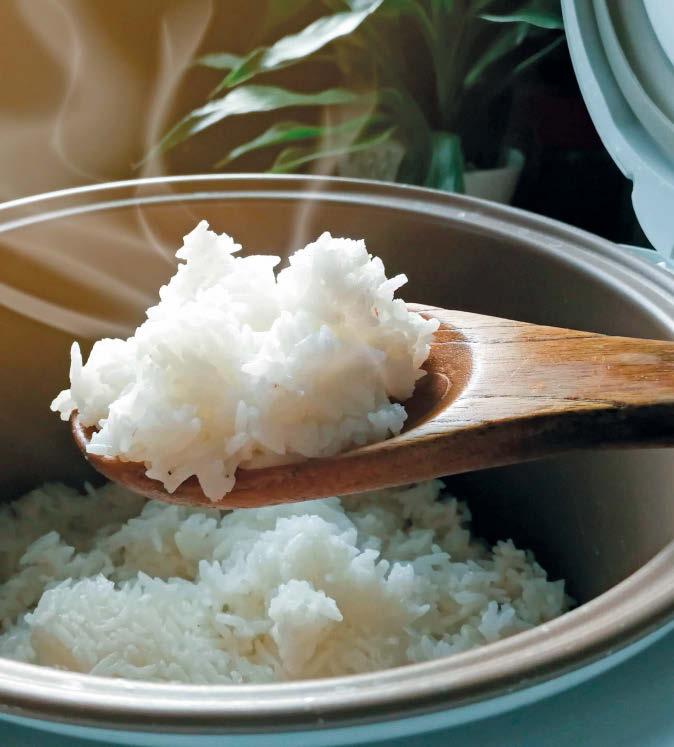
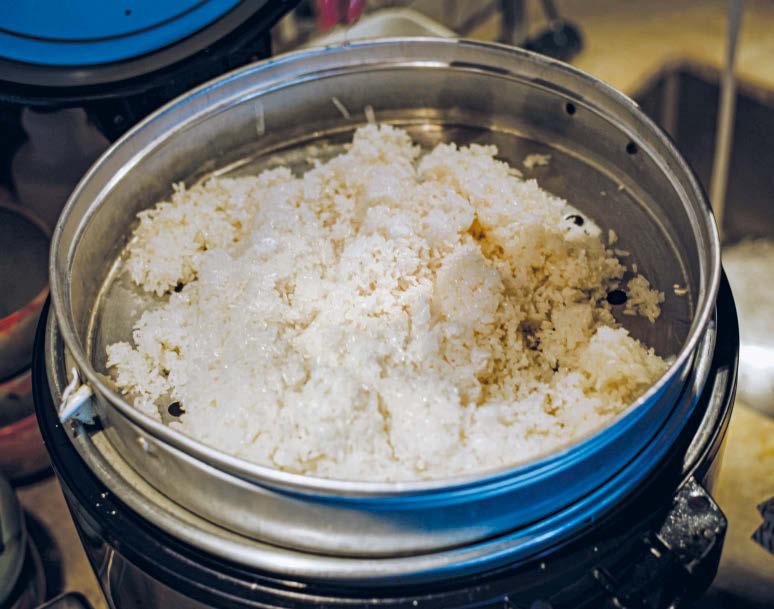


19
Using Authentic Thai Ingredients
Here’s an alphabetized rundown of the most common ingredients in Thai cooking that you are likely to encounter, and good substitutes for some of them if you can’t get hold of the originals.

Amaranth (pak kom jeen) is often sold in the West as a grain, but in Asia, it’s a spinach-like leaf that is usually stir-fried or added to stews and soups. You’ll find this in wet markets. Amaranth is cooked all over Asia; because of this, the most common form is known in Thailand as “Chinese spinach.” The red-leafed version is known as pak kom bai dang, or “red-leafed spinach,” while the type with thorns is pak kom naam (“thorny spinach”). Obviously, spinach and kale make great substitutes for this vegetable.
Asian Chives (gui chai) Also known as garlic chives or Chinese chives, this herb is taller and sturdier than Western chives, and is most commonly used in pad Thai. Although it would be preferable to use this ingredient when making
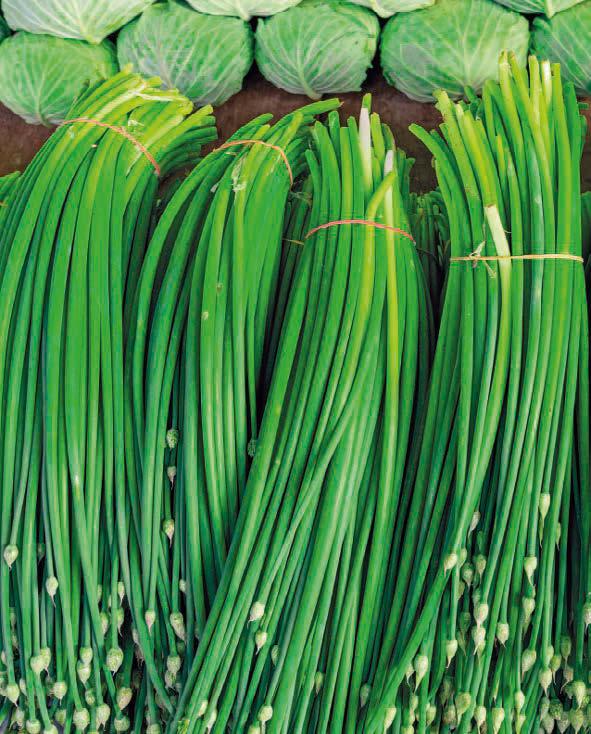
your pad Thai noodles, you can always use Western chives in its place if you cannot find Chinese chives.
Bamboo shoots (naw mai) are commonly found in Northern, Northeastern, and Central Thai cuisines in soups and curries and as boiled accompaniments to various nam prik (chili dips). In the Isaan region, various delicious spicy-tart stews are made with this vegetable, but Isaan’s most popular bamboo shoot-centric dish is probably soup naw mai, a salad of shredded bamboo shoots served warm in a salty-tart dressing with mint.
Bananas (gluay) Thailand is lucky enough to be host to myriad variations of the banana, including the small, stumpy gluay kai (egg
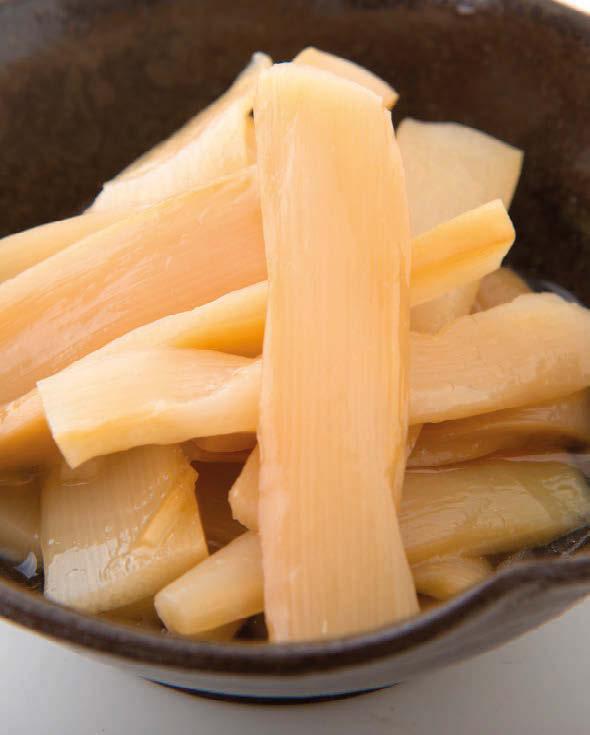
banana) and petite, delicate gluay leb mue nang (lady finger banana). The banana that the West is most familiar with is the gluay hom (fragrant banana), but the one probably most prized in Thailand is gluay nam wah (Thai banana), which is sweet, starchy and suitalbe for a number of Thai desserts. The leaves of the gluay nam wah tree are also used to wrap up food before grilling them for chili dips. They are also used to wrap food before steaming.
Banana blossom (hua plee) The unripened blossom of the banana tree is also put to great use, as either a raw accompaniment to “greasy” dishes like pad Thai, or boiled and shredded in its own sweet-tart Central Thai salad, yum hua plee. Because it can be quite
20
REAL THAI COOKING
AMARANTH ASIAN CHIVES BAMBOO SHOOTS

Basil When basil is mentioned, people naturally think of the Italians, but Thai food is also reliant on this herb. In fact, Thais rely so much on basil in their cuisine that they grow various different varieties locally. All the same, these leaves are rather fragile, so keep your basil in a cool but dry place. Once it turns black, you will have to toss it away. If you cannot find Thai types of basil in your market, go ahead and use the Italian kind for the smell.The three main types used in Thai cuisine are detailed below:
Holy basil (bai krapao) A thinner green leaf that lends itself to pepper y or spicy dishes, adding a sweet, metallic undertow to the spice and a pungent aroma. The most famous Thai dish featuring this herb is, of course, Pad Krapao Basil Stir Fry, considered the unofficial national dish of Thai-
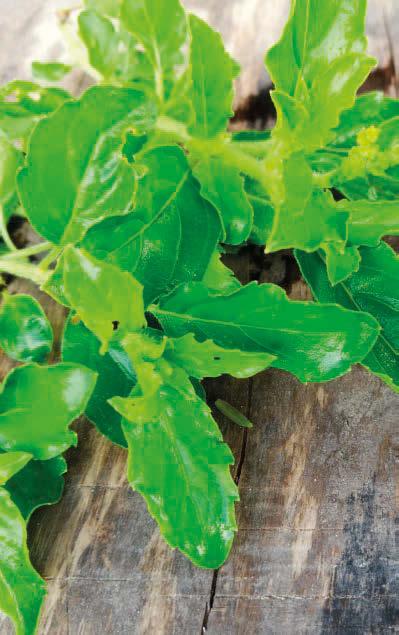
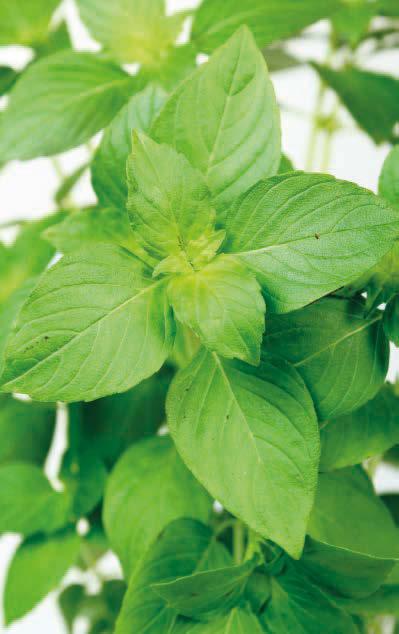
land. Holy basil also features prominently in drunken noodles, pad cha (spicy wild ginger stir fry), and in some versions of gang som (sour curry).

Lemon basil (bai mangrak) This herb is considered sweeter than holy basil and gives off a pleasant, citrusy aroma. For this reason, it is most commonly used with seafood and in soups, as well as in a nice
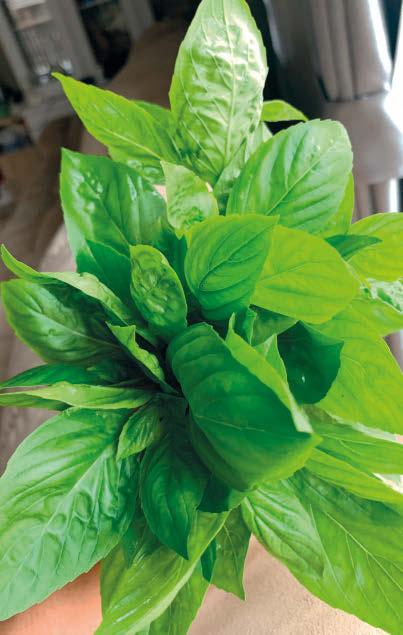
steamed mussel or clam dish.
Sweet basil (bai horapa) Ubiquously referred to in the West as “ Thai Basil.” This herb is, as the name suggests, “sweet,” with wide, bright green leaves. It figures prominently in one of Thailand’s most famous dishes, gang kiew waan (green curry). It also serves nicely in a stir-fry, making it a nice variation on the usual pad krapao.

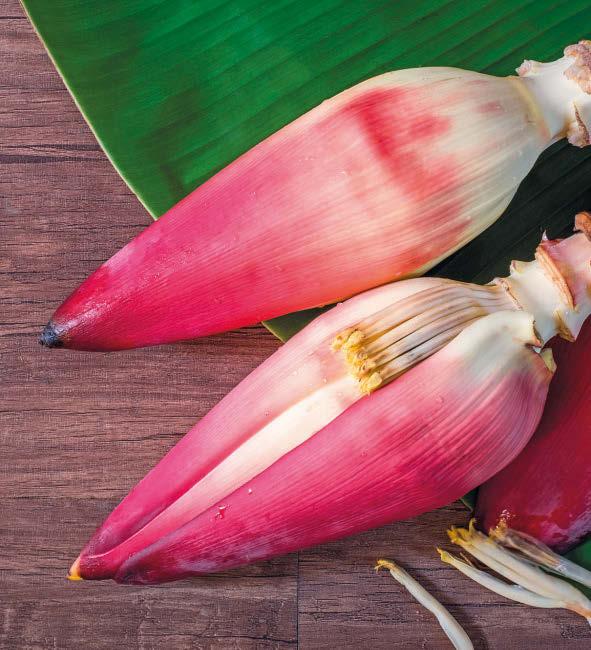
meaty and takes on other flavors well, Western cooks have started turning to this ingredient as a good substitute for meat or fish, hence
its emergence on some grocery store shelves. However, if you cannot find banana blossom at your local grocer, think of either canned young jackfruit or canned artichoke as substitutes.
Bean sprouts (tua ngok) Most commonly seen as the accompaniment to soup noodles or fried noodle dishes, bean sprouts when stir-fried in garlic is also a popular side dish to go with khao thom (rice porridge). You typically see bean sprouts with dishes that are considered “Chinese” like noodles and rice porridge.


Bitter Melon (mara) Thais believe the older you get, the more you will appreciate this. I believe this must be true, because I now love it. This
21 USING AUTHENTIC THAI INGREDIENTS
HOLY BASIL
BANANA BLOSSOM BEAN SPROUTS
SWEET BASIL
LEMON BASIL

Chilies (prik) Few ingredients are more intertwined with the identity of a country than chilies are with Thailand. Funnily enough, chilies did not grow in Thailand originally; they were brought to Thailand by the Portuguese, who carried them on their travels from Africa. Since then, Thais have wholeheartedly embraced this ingredient, and consider it a “health food” on par with ginseng and cordyceps.
Banana peppers (prik yuak) These relatively large (the length of your hand) peppers are a bright chartreuse color and boast a mild, slightly peppery taste. In the Central region, they are often sliced and stir-fried in Thai-Chinese dishes like chicken with cashew nuts, or pickled in vinegar to be sprinkled over noodles. They can also be stuffed with ground pork and encased in an egg netting
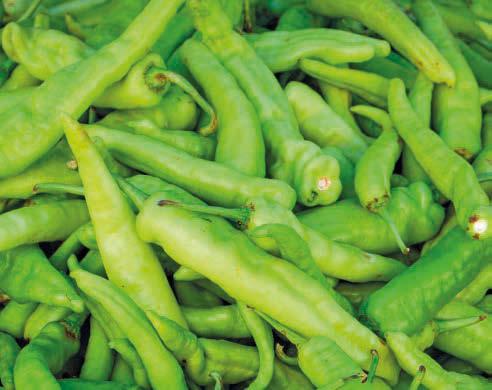
as accompaniment to the popular Central dish “summertime rice.”
Bird’s eye chilies (prik kii nuu) Of all the chilies in Thailand, these are the ones most associated with its food. Named in Thai after mouse droppings, these chilies are formidably spicy and feature prominently in all regional cuisines. There are few Thai households that do not host one or two plants of their own; at every meal, they are either served fresh and whole on a plate or sliced and used to flavor fish sauce (nam pla prik). These keep well in the freezer.
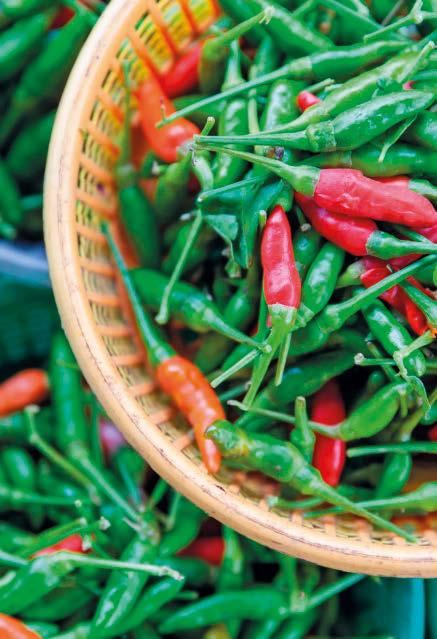


Chili powder (prik pon) A staple on the soup noodle table, this is sim-
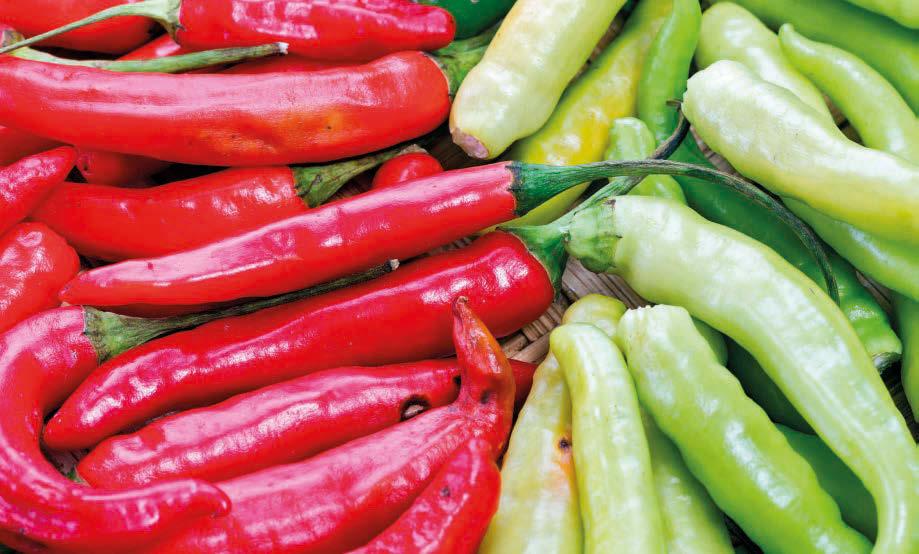
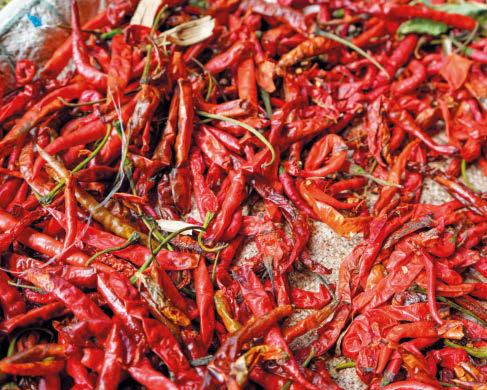



ply ground dried chilies. They are typically added to finished dishes at the table to increase heat. Dried chilies (prik hang) When red chilies are dried, they become even more pungent and insistent in their spice level. In the North, they are used sparingly as garnishes to ground meat salads like larb. In the South, they are added to spice mixtures to amplify the spices that are already there, making that cuisine the spiciest in all the land. Goat peppers (prik chee fah) Also known as spur or finger-length chilies, “red” or “green” chilies, they are larger than bird’s eye chilies and feature pointed ends rather than the snub noses on the bird’s eyes. They can be used in any recipe in place of bird’s eye chilies and are generally considered milder in spice level.
Young Northern Thai chilies (prik num) Reminiscent of goat pep-

pers, these are similar in length but of a brighter green color. Prevalent in Northern Thailand, they are roasted, peeled and pounded in a mortar and pestle to form nam prik num or roasted green chili dip.
Roasted chili paste (nam prik pao) This is a standard seasoning in Thai cuisine, sold in markets in every corner of the country. It is most commonly used as a seasoning at the table, added to dishes like one would add salt or pepper.


22 REAL THAI COOKING
BANANA PEPPERS
BIRD’S EYE CHILIES
ROASTED CHILI PASTE
YOUNG NORTHERN THAI CHILIES
GOAT PEPPERS
DRIED CHILIES
jade-colored (though sometimes it’s porcelain white) wrinklyskinned marrow is really delicious when stewed, and when raw or blanched, makes a great counterpoint to salty ingredients, paradoxically making them sweeter. Note: Sometimes it’s called “bitter gourd” in recipes, but in most recipes I’ve seen, that’s actually another melon (smaller and deep green with a pebbly skin) that’s even more bitter (sometimes it’s referred to as mara kii nok or “Thai bitter melon,” as opposed to the bigger and mellower “Chinese bitter melon.” We are only using the bigger bitter melon in these recipes).
Cabbage (galumplee) This vegetable did not originally grow in Thailand, but since its introduction to the country (probably via the Portuguese), Thais have taken to it as either a raw accompaniment to a spicy salad like larb or som tum, or stir-fried in fish sauce as part of a standard Central Thai meal.
Cardamom (luk grawan) This spice most likely came to Thai-
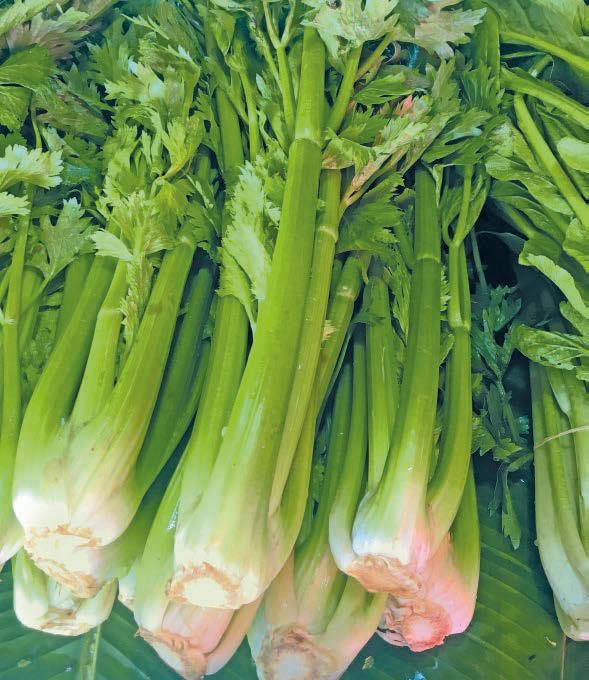
land via its neighbor, India, or Malaysia to the South. It is used in much of the South, most notably in Muslim-Thai Southern dishes like massaman curry. There are different kinds of cardamom: the Thai kind is more delicate than its green Indian counterpart, which is easier to find in the West. If using the Indian kind, use slightly less and in recipes like massaman curry, which calls for a chili paste to be made, remove the seed from the exterior pod before using or the flavor will be a bit harsh.
Celery (gunchai) Unlike Western celery, Thai celery has a thin stalk and large leaves, making it very fragrant. It is commonly used as a seasoning to spicy Thai salads like yum, where it adds crunch and a grassy underpoint to all of the chilies, which offsets the spice. Of course, you can use Western celery in place of this ingredient. However, it won’t be as fragrant.
Cinnamon (ob choy) This is not an ingredient many would associate with Thai cuisine, but it is used in some dishes, most notably in Northern Thai larb. However, it is not used in any Thai desserts.
Coconut (maprao) This is a native Thai ingredient that is still widely used even today (although not so much in Northern and Northeastern cooking). Coconut flesh is important in Thai desserts, and the young coconut itself is popular as a refreshing drink all over Thailand.
Coconut milk (kati) The milk of the coconut, much easier to ob-

tain today than in the olden days, features in both sweet and savory dishes, particularly from the Central region. While fresh coconut milk is obviously best, most supermarkets now carry canned and/or UHT iterations of coconut milk. Thais often separate the ”head” or thick cream of the coconut milk from the “tail” or watery coconut milk, adding them in different stages of the cooking process. Coconut cream is also used more widely in desserts, often as topping for sweet sticky rice.
Coconut shoots (yod maprao)
The fresh young flesh of the green coconut can be added to soups like spicy lemongrass soup, or in stir-fries like in drunken noodles. They can also be made into a spicy yum salad. If you cannot find coconut shoots, you may want to use canned hearts of palm instead.
Coriander leaves (pak chee, aka cilantro) This herb is either loved or hated by diners. Some liken its smell and taste to that of bedbugs; others associate the smell with greenery and freshness (I fall
23
USING AUTHENTIC THAI INGREDIENTS
CELERY
COCONUT MILK
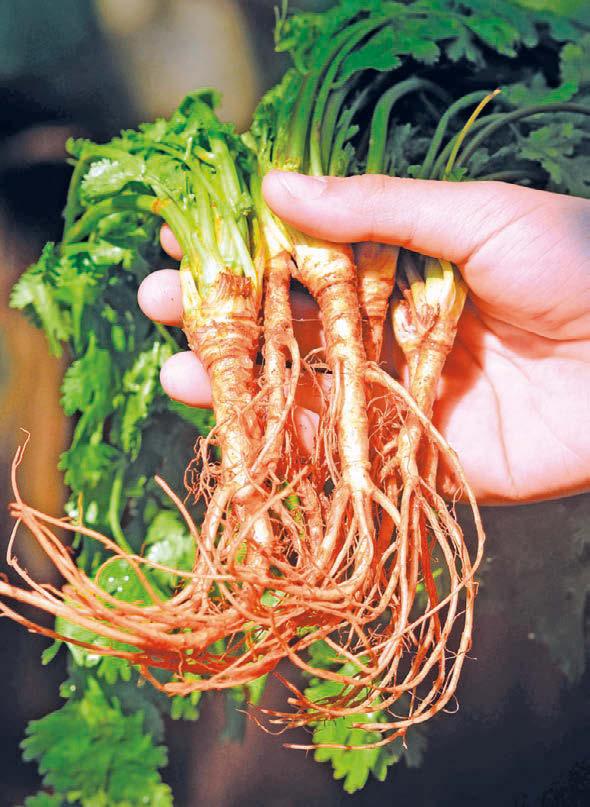
into this camp, of course). In any case, if you love coriander leaves, there really is no substitute for it. Just make sure not to confuse it with Italian parsley. No need to destem; both the leaves and stems, chopped, are used in Thai cooking.
Coriander root (rak pak chee, aka cilantro root) Again, this is coriander smell and flavor, concentrated. This ingredient is integral to many a Thai curry paste, chili dip or marinade. Of course, if you dislike coriander leaves, you will also dislike its root. If you do happen to like coriander leaves, make sure to save the roots in a Ziploc bag and store in a dry place in your refrigerator. Please keep in mind that the coriander roots sold outside of Thailand are quite small; if you are abroad, please use 2–3 roots for every root called for in the recipe. I’m told that in Europe, the roots are so flimsy as to be unusable; in that case, use stems mixed with leaves as a substitute.
Coriander seed (luk pak chee) Of course, coriander seeds are also used in curry pastes and marinades. As they are sold in the spice section, these can also be used as substitutes for coriander root if the roots you find are lacking.
Cucumber (thang gua) Out of all the vegetables in your garden, the humble cucumber may be the most useful for your Thai cooking explorations. Refreshing cucumber slices go with everything in Thai cuisine, from fried rice to larb to som tum to chili dips. Thais use them to counteract any spiciness; it’s considered a better spice-buster than water.
Cumin seeds (yee rah) This spice, which probably came to Thailand from Malaysia, is used in many curry pastes, including green curry and massaman curry. It is always roasted and then pounded.
Curry powder (pong garii) No, it doesn’t form part of a standard Thai curry paste. Instead, it is used
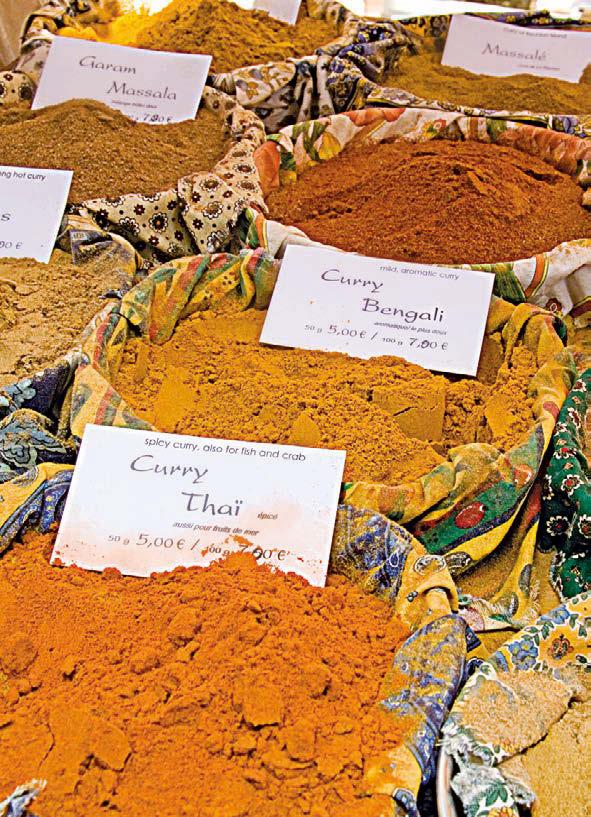
in Thai-Chinese dishes like in poo pad pong karii (crabs stir-fried in curry sauce). In this book, we will be using shrimp (page 66) in place of crab for this iconic dish.
Dill (pak chee lao) This herb is used extensively in Northeastern cuisine as it imparts a fresh, “green” flavor to soups and stews. Unlike in the West, it is not used with seafood. Strangely enough, the Thai name for this herb translates roughly to “Lao cilantro,” even though it is commonly used in the West.
Dried shrimp (goong hang) This ingredient can be ground up and added to salads and chili dips, or mixed in with the “Thai” version of som tum, considered sweeter and less pungent than the typical Isaan version of the grated salad.
Eggs (kai) Strangely enough, Thais used duck eggs more than chicken eggs in their cooking, and prize duck eggs over chicken eggs. Boiled eggs are common accompaniments to chili dips, salads and fried rice; they are not really hardboiled, but cooked just until the yolk begins to set (called yang matoom in Thai, or “rubber tree sap”). Omelets are also a common feature on the Thai table, especially in the South, where they help soak up all the spice and gravy in the dishes. Texture plays an important role. Thai omelets are deep-fried, meant to be fluffy and a bit crispy on the outside. Ground pork is a popular ingredient in Thai omelet, but crabmeat can also be added when the cook wants to go a bit luxe.
24 REAL THAI COOKING
CORIANDER ROOT
CURRY POWDER
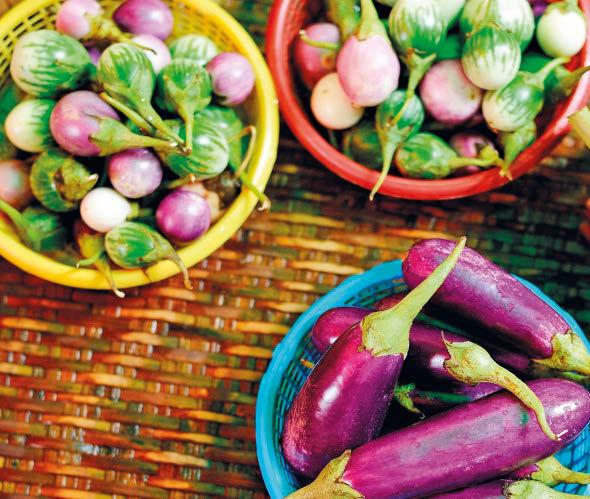
Eggplants (makuea) Unlike the “long” purple variety, Thai eggplants are commonly round and crunchy, useful for their tannic qualities in combating spice. Raw, they are common accompaniments to chili dips; boiled, they play a role in salads and curries.
Pea eggplants (makuea puong)

These tiny eggplants, sometimes mistaken for large green peppercorns, are used to combat spiciness. Their slight bitter flavor and crunch make them popular in green curries and shrimp paste chili dips.
Purple eggplants (makuea yao)
A recent arrival to Thailand’s shores, the purple eggplant is used mainly for the popular dish yum makuea yao (long eggplant salad), where it is grilled and served with ground pork and/or shrimp and slathered in a spicy-tart dressing and accompanied by boiled eggs.
Thai eggplants (makuea proh)
Bigger than pea eggplant, these are either served raw with chili dips or boiled in green curries, jungle curries, or in their own salads, where they are commonly mashed to a pulp to make Makuea Mashed Eggplant Salad (page 111) and garnished with mint and roasted rice kernels.
Fermented soybean disc (tua nao) This fermented bean paste is sold in a dried disc form and is the base for many Northern Thai dishes. Substitute shrimp paste (kapi) if you cannot find tua nao.

Fish sauce (nam pla) Possibly the most popular ingredient in Thai cuisine, this condiment is said to have come to Thailand via either the Chinese or Arab traders. It is made of fermented fish and is used to flavor nearly every dish in the Thai culinary lexicon. Meals with rice are always accompanied by a small bowl of fish sauce, flavored with a few squirts of lime juice and studded with sliced chilies and garlic. However, be careful—this ingredient does expire. Once it turns black, throw it away. If you are vegetarian and cannot use fish sauce, substitute with soy sauce.
Galangal (kha) Unlike ginger, for which it is commonly mistaken,

galangal bears a pinkish tinge near its “tail” and is considered cooling to Thais, instead of “heating” like ginger. It is used in many salads and soups, most notably thom kha, or the popular spicy-tart coconut milk-based soup. This keeps well in the freezer. If you absolutely cannot find galangal, you can substitute with ginger, but you must use less as ginger’s flavor is much harsher.
Garlic (gratiem) Thai garlic cloves are smaller and more pungent than their Western counterparts, making them valuable ingredients if you can find them in the West. If you cannot, of course, larger Western garlic cloves will do but use slightly less than what is called for in the recipe as Western garlic is far bigger. Beware when using raw garlic for recipes—Western cloves will be far harsher.
Ghee (nam mun gee) This is, like in Indian cooking, clarified butter used in recipes that have an Indian or Middle Eastern influence. If you cannot find ghee in your supermarket, simply heat some butter and strain the fats (a sieve lined with cheesecloth works best). The clear liquid that remains is the ghee.
Ginger (khing) This came to Thailand via the Chinese and is prized for its “heating” abilities. New mothers are fed copious amounts of ginger in the belief that this helps to promote the production of breast milk. Ginger also figures in morning drinks, in Chinese-style stir-fries, and in popular Chinese-
25
USING AUTHENTIC THAI INGREDIENTS
THAI EGGPLANTS
GALANGAL
style desserts. You’re likely to find it anywhere, but if you’re really strapped, use ginger powder.
Hibiscus (grajieb) Also known in English as roselle, it is confusingly referred to in Thai as grajieb, which is also the Thai word for okra. However, this red flower is most commonly used in syrup for drinks and sweets and as natural food coloring for desserts.
Jasmine rice (khao hom malee)
The most important ingredient in Thai cuisine, jasmine rice is synonymous with Thai “food.” Oldfashioned Thais still believe that the evening meal, the most important meal of the day, must be centered around rice, not noodles.
Kaffir lime (magrood) These limes are pebbly on the outside, yielding little juice. The juice, however, is considered a good ingredient with which to wash one’s hair. The rind, on the other hand, is an important seasoning in many curries and chili dips. If you cannot find kaffir limes, you can use regular limes.


However, the kaffir lime leaves, or bai magrood, are some of the most ubiquitous ingredients in Thai cooking. They are used in salads, curries, soups and stir-fries, and have no substitute. Most Asian supermarkets stock it. For this reason, buy a lot when you do see them, as they keep well in the freezer.
Lemongrass (thakrai) This has no real substitute and is widely used in Thai cooking. Aromatic and grassy, it is used in marinades, curry pastes, chili dips, salads and soups. The tough outer layers should be peeled away and only the thick lower third of the stem used. It’s easiest to julienne it or use bruised larger bulbs that can then be fished out before eating. Lemongrass keeps well in the freezer, so buy a lot of it when you see it.
Limes (manao) This fruit is considered one of the ingredients that define Thai cuisine, adding its tartness to the brew that makes up the “salty-spicy-tart-sweet-bitter” flavor profile known all over the world. Thai cuisine only uses naturally sour ingredients and does
not incorporate vinegar, which is considered Chinese. The limes in Thailand are more like key limes, thinner-skinned with more juice. Alas, the larger, thicker-skinned Persian variety is the type more commonly sold in the U.S.

Mango (mamuang) When green, this can also be used as a “tartener,” adding its sour flavor to the mix. Of course, everyone loves this fruit during the Thai “summer” (March–April), when the weather is at its hottest and juicy, orange mangoes fill the markets. The most popular type of mango is probably nam dok mai, which is juicy and has no filaments, but most Thais I’ve talked to prize the ok krong mango for its fragrant smell. Green mango (mamuang kieo) This type of mango is served green and has a tart, slightly sweet flavor that goes perfectly with salads, dressings for fried fish, or simply cut and dipped into a salty-sweet sauce (nam pla wan).

26 REAL THAI COOKING
HIBISCUS
KAFFIR LIME

Noodles (sen) This ingredient came to Thailand courtesy of the Chinese, who began selling it by Bangkok’s canals in the 1800s, giving rise to the country’s first street food.
Egg noodles (bamee) These curly yellow noodles are adopted from the Chinese and resemble instant ramen in the pack. Glass vermicelli (woon sen) Made of mung beans, these noodles are ser ved in soups or in salads.
Rice noodles (sen guay thiew, sen lek, sen yai, sen mee, sen chan) Different iterations of these noodles—thin, thick, vermicelli, or rice stick—are used for either soup noodles or in fried noodle dishes like pad Thai.

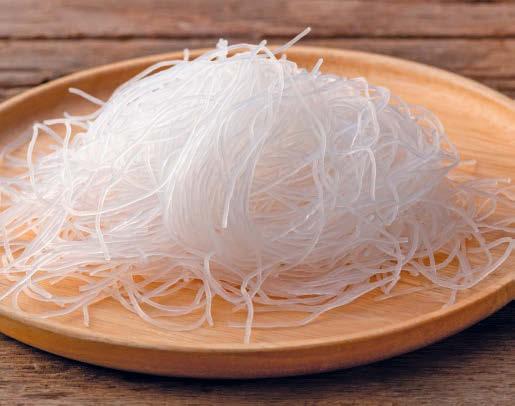

Mint (bai saranae) This herb is mostly used in the Northeast, as a garnish for ground meat salads (Isaan-style larb) and som tum
Ngiew blossoms (dok ngiew) In the recipe for Nam Ngiew Pork and Tomato Sauce Noodles (page 105), these dried blossoms are the central player, thanks to their chewy texture and slightly floral aroma. If you cannot find it, try to substitute with a chewy mushroom like shiitake cut into strips or enoki mushrooms thrown in at the last minute.
Orange, bitter (som saa) Oldfashioned Central Thai recipes make much use of the bitter orange, which is far more aromatic than
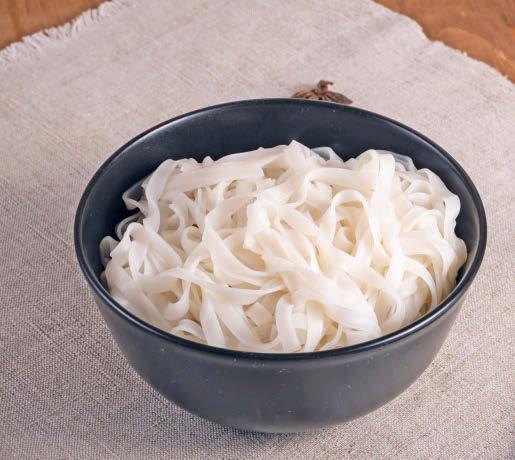

regular oranges. Because this is an ingredient hard to procure even in Thailand nowadays, you can substitute by combining orange juice and zest with lime juice and zest.
Palm sugar (nam than peep) One of Thailand’s most important seasonings, this is considered more restrained and “rounder” in flavor than regular sugar. Of course, if you do not have palm sugar, regular sugar will do, but regular sugar is said to impart a harsher, sharper sweetness to a dish. Keep palm sugar in a cool, dry place. Since most palm sugar comes in disc form in Thailand, it must be shaved or grated for use in recipes.

Pandanus leaves (bai thuey)
Imparting a green, powdery aroma, these leaves are used in refreshing drinks, steaming rice, or in desserts where they are also used as natural food colorings, lending a fresh celadon hue to food.
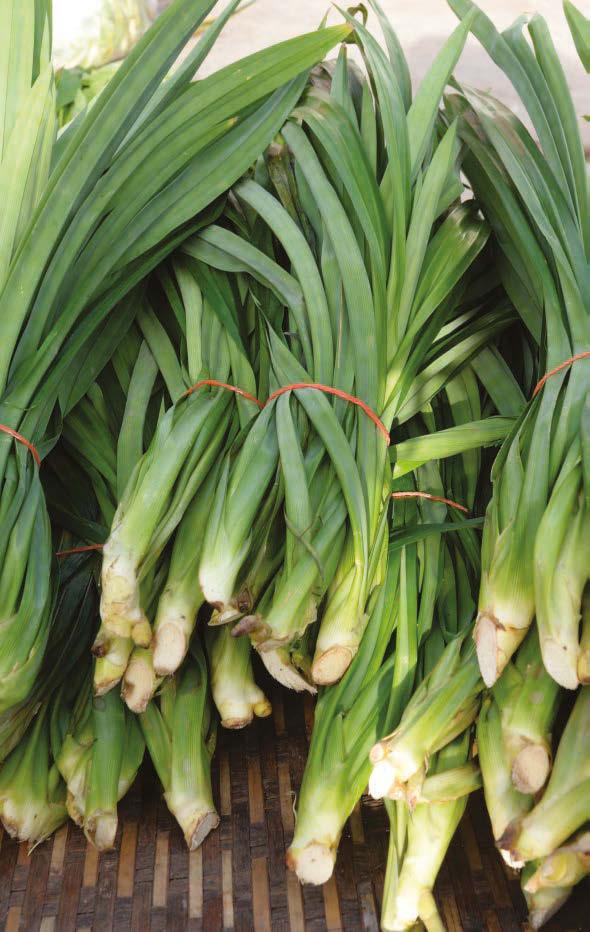
Papaya (malagaw) This fruit grows in profusion in Thailand, but is perhaps most famously used while green in the Northeast as a major
27
USING AUTHENTIC THAI INGREDIENTS
EGG NOODLES
GLASS VERMICELLI
RICE NOODLES
PALM SUGAR
PANDANUS LEAVES
ingredient in Isaan grated salads, or som tum. In the South, both green and ripe papaya can be used in soups like gang som. Fresh ripe papaya is also considered a good antidote to constipation.
Peppercorns (prik Thai awn)
Before chilies, green peppercorns were considered the original Thai spice. They are still important, featuring prominently in stir-fries like drunken noodles and in chili dips. When blackened, they are called prik Thai. If you cannot find green peppercorns in your grocery store, you can substitute black peppercorns.
Pineapple (sopparot) Another ingredient that grows in profusion in Thailand, the smaller, tart variety grown in the North and the sweet, larger type grown in the South are now cross-bred to form small, sweet, crunchy pineapples known as phu-lae, a highly prized variety in Bangkok. When eaten fresh, it is said to be good for digestion.
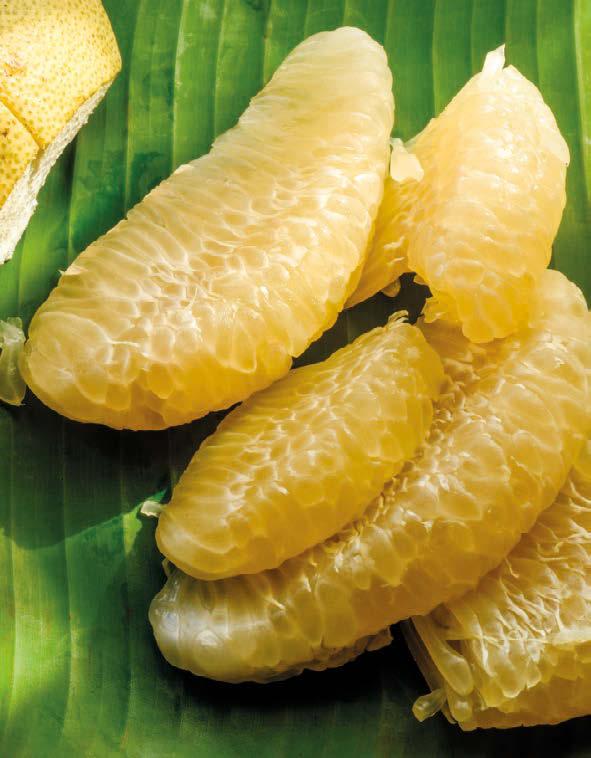

Pomelo (som o) The season for this grapefruit-looking fruit is October–February. Unlike grapefruit, pomelo can be eaten in segments and has a slightly sweeter taste. Grapefruit can be used in its place.
Roasted rice kernels (khao kua) A common seasoning in the Northeast, rice kernels are roasted in the pan and then ground in a mortar and pestle. When sprinkled on a salad or meat, they add a smoky aroma and a nutty taste.
Sawtooth coriander (pak chee farang) Reminiscent of blades of grass, this herb boasts serrated edges and a sharp, fresh flavor that some say betrays a “soapy” character. Funnily enough, the Thai name for this herb is roughly translated to “Western coriander,” even though few Westerners use it in their cooking.
Shallots (hom dang) As important an ingredient as garlic, Thai shallots are smaller and more fragrant than their Western counterparts. They are used in chili dips, marinades, curry pastes, and salads. If using Western shallots, use less
than what is called for in the recipe because Western shallots are far bigger. Raw shallots, if Western, should be used with caution.
Shrimp paste (kapi) The base ingredient in Central Thai cuisine, this is made of pulverized krill. The best variety is from Samut Sakhon, a coastal province south of Bangkok. Said to have come to Thailand via the Chinese, this ingredient provides a deep umami to any dish. Because it is hard to find a substitute, it’s best to omit it and use fish sauce instead.
Soy sauce (see ew) This ingredient is Chinese, but is now used

28 REAL THAI COOKING
SAWTOOTH CORIANDER
POMELO SOY SAUCE
in place of fish sauce in vegetarian and vegan recipes. You can also find it in many Chinese-Thai dishes like pad see ew (noodles stir-fried in soy sauce). Thais call the typical soy sauce see ew khao, which means “white soy sauce”; it’s not white, but it’s not the thick, sweet flavored sauce that is known as “dark soy sauce,” “black soy sauce,” or see ew dum. Needless to say, neither “white soy sauce” nor “black soy sauce” are the tamari soy sauce of Japanese origin, formed from the byproduct of miso paste.
Sticky rice (khao niew) The staple starch in Northern and Northeastern Thailand, this rice acts as a sort of edible utensil for both cuisines, which are eaten by hand.
Tamarind (makaam) This fruit, which is said to have somewhat of a laxative effect, is eaten as a snack, but the pulp is widely used in Thai cooking. Tart tamarind leaves are also used to flavor sour soups. Tamarind pulp comes in a hard block that you have to add to hot water to reconstitute the juice. Both of these keep well in the freezer. To make tamarind juice—a staple ingredient in Thai cooking—mix the pulp with some water. Mash with your fingers and strain to obtain the juice, discarding the pulp.
Thai anchovy (pla rah) This ingredient is ubiquitous in the Northeast. They are river fish mixed with sea salt, placed in a clay jar and allowed to ferment for weeks or even months. Use West-
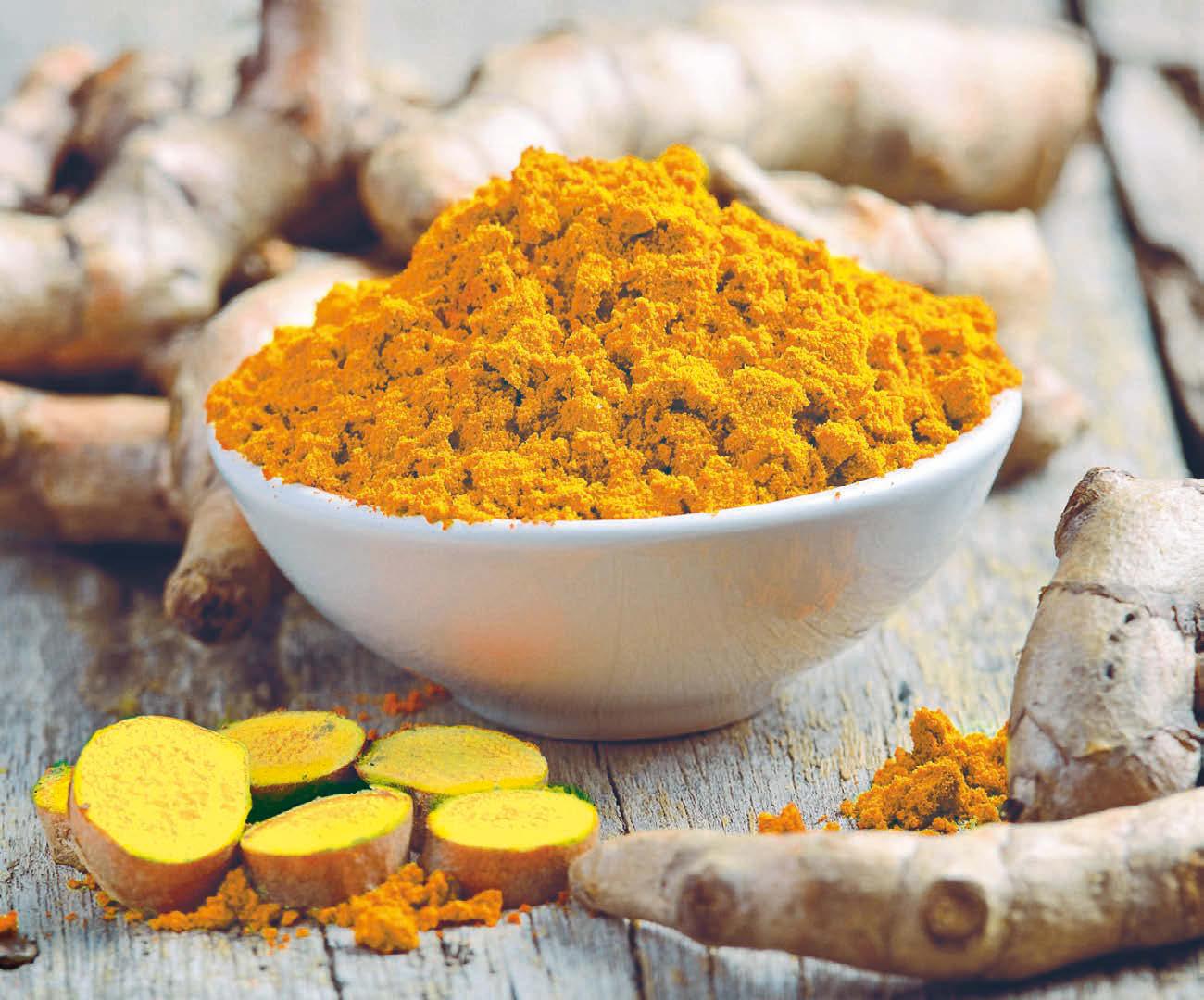
ern anchovies if you cannot find Thai anchovy.
Tomatoes (makuea tet) Perhaps because of their roundness, tomatoes have been given a similar name to eggplants, but that’s where the similarity ends. A recent arrival to Thailand, tomatoes now feature in Northern Thai stews, Central Thai curries, and even som tum. The varieties grown in Thailand are not known for their sweetness and aroma, but farmers are making inroads on this issue, even reproducing some of the heirloom strains grown in the West.
Turmeric (kamin chan) This ingredient is used fresh, and is mostly used in curry pastes, although it also plays a role in Northern Thai sausage. When peeled by hand, it does tend to stain the fingers for a few days, as well as any equipment
you’re using to process it. If fresh tamarind cannot be located, try the dry spice instead.
Wild ginger (grachai) Also known as “finger root,” this herb has a fresh, bright flavor that makes it an ideal pairing with seafood. It features in curry pastes as well as in chili dips and stir-fries like pad cha (“numbingly spicy stir-fry”).
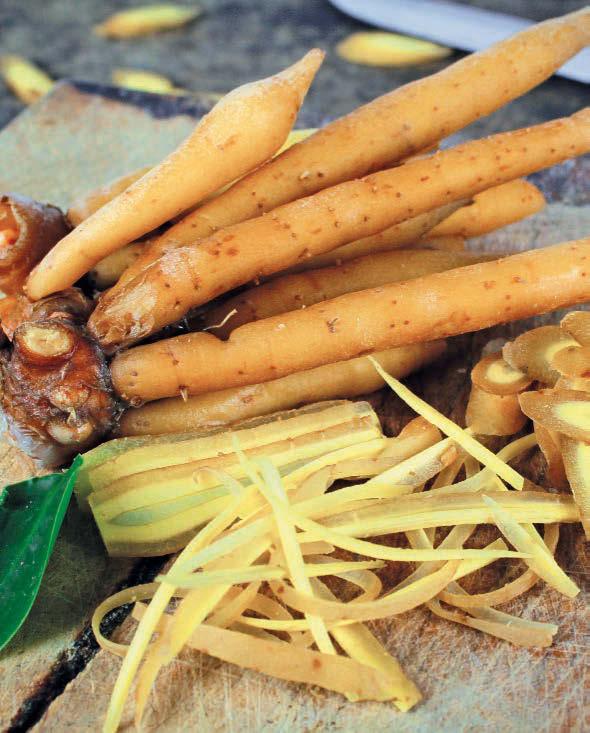
29
USING AUTHENTIC THAI INGREDIENTS TURMERIC WILD GINGER
Authentic Thai Dips and Sauces
Nam Pla Prik Fish Sauce with Chilies
This is the condiment that comes with every bowl of steamed rice set on a Thai table. It’s basically fish sauce, flavored with lime juice, some raw garlic, and a number of sliced fresh bird’s eye chilies (depending on your spice level). You can eyeball this, or follow the recipe below, which serves as a basic blueprint.
SERVES 1 • PREP TIME: 5 MINUTES
3 tablespoons fish sauce per person
½ clove garlic, sliced 3–5 bird’s eye chilies per person, sliced ½ tablespoon lime juice per person
In a bowl, mix the fish sauce, garlic, chilies and lime juice. Serve with a small spoon alongside a Thai meal with steamed jasmine rice.

Fish Sauce and Its Importance in Thai Cooking
There exists a certain kind of Thai person who believes that a dish isn’t truly Thai unless it has fish sauce in it. This would make Thai vegetarian food, at its heart, an oxymoron. It would also make some local idiosyncrasies, like my family’s fondness for Maggi Seasoning or my friends’ preferences for salt, aggressive acts in culinary vandalism.


But some food experts beg to differ. Chef Bo Songivsava, of the critically lauded restaurant Err, says that the insistence on fish sauce as a major pillar of Thai cuisine is simply another example of the Central Thais placing their own food front and center.
“Fish sauce may have a significant flavor profile of Thai food, but there are so many dishes that are seasoned without fish sauce,” she said. “Lots of Northern Thai dishes are based on salt and other salty seasonings such as tua nao (fermented soybean disc), tao jiew (fermented brown bean sauce) or nam puu (concentrated field crab juice). In both Northeastern and Northern Thailand, the fundamental seasoning is pla rah (fer-

mented Thai anchovies) while those in Southern Thailand is heavily based on shrimp paste and local soy sauce.”
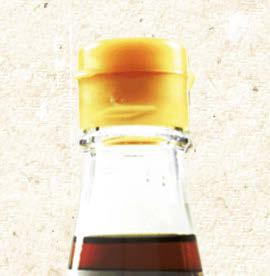

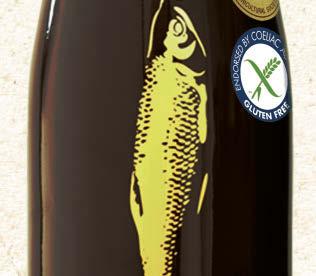
However, despite the myriad seasonings mentioned, no one can deny that fish sauce still plays a big part in Thai cuisine—especially if you are talking about Bangkok and the Central plains. When encountering a Thai recipe out in the wild, it is always best to arm oneself with a good bottle of fish sauce, just in case. “We are not a huge fan of commercial fish sauces in general,” said Chef Dylan Jones, the other half of Err. “However, there are a few brands that we fall back on when we are overseas, such as Megachef and Squid brand. Megachef is more fragrant and not overly salty like other commercial fish sauces; however, it is a little on the sweet side. Squid brand has a decent fragrance and is not too sweet.”


Of course, Chefs Bo and Dylan brew their own sauces back home. Cooks interested in tr ying their fish sauce can go to Bo.lan Grocer’s Facebook page at facebook.com/bolangrocer.
30 REAL THAI COOKING
B o

































































































































































